Ceramic-Based Dielectric Materials for Energy Storage Capacitor Applications
Abstract
1. Introduction
2. Fundamental Concepts for Energy Storage in a Dielectric Capacitor
2.1. Dielectric Capacitor
2.2. Evaluation of Energy Storage Performance
2.3. Key Parameters for Energy Storage Performance
2.3.1. Energy Storage Density and Efficiency
2.3.2. Polarization Difference
2.3.3. Dielectric Breakdown Strength
2.3.4. Discharge Time
2.3.5. Reliability
2.4. Categories of Dielectric Materials
2.5. Energy-Storage Mechanism of the Materials
3. Dielectric Materials for Energy Storage
3.1. Bulk Ceramics
3.1.1. Linear Dielectrics
3.1.2. Ferroelectrics
3.1.3. Anti-Ferroelectrics
3.1.4. Relaxor Ferroelectrics
3.2. Ceramic Films
3.3. Multilayer Ceramic Capacitors
4. Challenges and Future Prospects
5. Conclusions
Author Contributions
Funding
Institutional Review Board Statement
Informed Consent Statement
Data Availability Statement
Conflicts of Interest
References
- Yao, Z.; Song, Z.; Hao, H.; Yu, Z.; Cao, M.; Zhang, S.; Lanagan, M.T.; Liu, H. Homogeneous/Inhomogeneous-Structured Dielectrics and Their Energy-Storage Performances. Adv. Mater. 2017, 29, 1601727. [Google Scholar] [CrossRef]
- Kang, B.; Ceder, G. Battery Materials for Ultrafast Charging and Discharging. Nature 2009, 458, 190–193. [Google Scholar] [CrossRef]
- Luo, X.; Wang, J.; Dooner, M.; Clarke, J. Overview of Current Development in Electrical Energy Storage Technologies and the Application Potential in Power System Operation. Appl. Energy 2015, 137, 511–536. [Google Scholar] [CrossRef]
- Kumar, N.; Ionin, A.; Ansell, T.; Kwon, S.; Hackenberger, W.; Cann, D. Multilayer Ceramic Capacitors Based on Relaxor BaTiO3-Bi(Zn1/2Ti1/2)O3 for Temperature Stable and High Energy Density Capacitor Applications. Appl. Phys. Lett. 2015, 106, 252901. [Google Scholar] [CrossRef]
- Li, J.; Li, F.; Xu, Z.; Zhang, S. Multilayer Lead-Free Ceramic Capacitors with Ultrahigh Energy Density and Efficiency. Adv. Mater. 2018, 30, 1802155. [Google Scholar] [CrossRef] [PubMed]
- Palneedi, H.; Peddigari, M.; Hwang, G.-T.; Jeong, D.-Y.; Ryu, J. High-Performance Dielectric Ceramic Films for Energy Storage Capacitors: Progress and Outlook. Adv. Funct. Mater. 2018, 28, 1803665. [Google Scholar] [CrossRef]
- Dong, J.; Hu, R.; Xu, X.; Chen, J.; Niu, Y.; Wang, F.; Hao, J.; Wu, K.; Wang, Q.; Wang, H. A Facile In Situ Surface-Functionalization Approach to Scalable Laminated High-Temperature Polymer Dielectrics with Ultrahigh Capacitive Performance. Adv. Funct. Mater. 2021, 31, 2102644. [Google Scholar] [CrossRef]
- Yang, H.; Tian, J.; Lin, Y.; Ma, J. Realizing Ultra-High Energy Storage Density of Lead-Free 0.76Bi0.5Na0.5TiO3-0.24SrTiO3-Bi(Ni2/3Nb1/3)O3 Ceramics under Low Electric Fields. Chem. Eng. J. 2021, 418, 129337. [Google Scholar] [CrossRef]
- Li, Q.; Yao, F.-Z.; Liu, Y.; Zhang, G.; Wang, H.; Wang, Q. High-Temperature Dielectric Materials for Electrical Energy Storage. Annu. Rev. Mater. Res. 2018, 48, 219–243. [Google Scholar] [CrossRef]
- Li, Q.; Chen, L.; Gadinski, M.R.; Zhang, S.; Zhang, G.; Li, H.U.; Iagodkine, E.; Haque, A.; Chen, L.-Q.; Jackson, T.N.; et al. Flexible High-Temperature Dielectric Materials from Polymer Nanocomposites. Nature 2015, 523, 576–579. [Google Scholar] [CrossRef]
- Choi, H.; Ryu, J.; Yoon, W.-H.; Hwang, G.-T. Recent Progress in Dielectric-Based Ultrafast Charging/Discharging Devices. J. Korean Inst. Electr. Electron. Mater. Eng. 2022, 35, 322–332. [Google Scholar]
- Tang, H.; Lin, Y.; Sodano, H.A. Synthesis of High Aspect Ratio BaTiO3 Nanowires for High Energy Density Nanocomposite Capacitors. Adv. Energy Mater. 2013, 3, 451–456. [Google Scholar] [CrossRef]
- Pandya, S.; Wilbur, J.; Kim, J.; Gao, R.; Dasgupta, A.; Dames, C.; Martin, L.W. Pyroelectric Energy Conversion with Large Energy and Power Density in Relaxor Ferroelectric Thin Films. Nat. Mater. 2018, 17, 432–438. [Google Scholar] [CrossRef] [PubMed]
- Lin, Y.; Li, D.; Zhang, M.; Zhan, S.; Yang, Y.; Yang, H.; Yuan, Q. Excellent Energy-Storage Properties Achieved in BaTiO3-Based Lead-Free Relaxor Ferroelectric Ceramics via Domain Engineering on the Nanoscale. ACS Appl. Mater. Interfaces 2019, 11, 36824–36830. [Google Scholar] [CrossRef] [PubMed]
- Kishi, H.; Mizuno, Y.; Chazono, H. Base-Metal Electrode-Multilayer Ceramic Capacitors: Past, Present and Future Perspectives. JPN J. Appl. Phys. 2003, 42, 1. [Google Scholar] [CrossRef]
- Wang, Y.; Cui, J.; Wang, L.; Yuan, Q.; Niu, Y.; Chen, J.; Wang, Q.; Wang, H. Compositional Tailoring Effect on Electric Field Distribution for Significantly Enhanced Breakdown Strength and Restrained Conductive Loss in Sandwich-Structured Ceramic/Polymer Nanocomposites. J. Mater. Chem. A Mater. 2017, 5, 4710–4718. [Google Scholar] [CrossRef]
- Yao, F.-Z.; Yuan, Q.; Wang, Q.; Wang, H. Multiscale Structural Engineering of Dielectric Ceramics for Energy Storage Applications: From Bulk to Thin Films. Nanoscale 2020, 12, 17165–17184. [Google Scholar] [CrossRef]
- Zhang, Y.; Yang, H.; Dang, Z.; Zhan, S.; Sun, C.; Hu, G.; Lin, Y.; Yuan, Q. Multilayer Structured Poly(Vinylidene Fluoride)-Based Composite Film with Ultrahigh Breakdown Strength and Discharged Energy Density. ACS Appl. Mater. Interfaces 2020, 12, 22137–22145. [Google Scholar] [CrossRef]
- Wang, Y.; Wang, L.; Yuan, Q.; Chen, J.; Niu, Y.; Xu, X.; Cheng, Y.; Yao, B.; Wang, Q.; Wang, H. Ultrahigh Energy Density and Greatly Enhanced Discharged Efficiency of Sandwich-Structured Polymer Nanocomposites with Optimized Spatial Organization. Nano Energy 2018, 44, 364–370. [Google Scholar] [CrossRef]
- Zhou, M.; Liang, R.; Zhou, Z.; Yan, S.; Dong, X. Novel Sodium Niobate-Based Lead-Free Ceramics as New Environment-Friendly Energy Storage Materials with High Energy Density, High Power Density, and Excellent Stability. ACS Sustain. Chem. Eng. 2018, 6, 12755–12765. [Google Scholar] [CrossRef]
- Chu, B.; Zhou, X.; Ren, K.; Neese, B.; Lin, M.; Wang, Q.; Bauer, F.; Zhang, Q.M. A Dielectric Polymer with High Electric Energy Density and Fast Discharge Speed. Science 2006, 313, 334–336. [Google Scholar] [CrossRef]
- Zhu, L.-F.; Zhao, L.; Yan, Y.; Leng, H.; Li, X.; Cheng, L.-Q.; Xiong, X.; Priya, S. Composition and Strain Engineered AgNbO3—Based Multilayer Capacitors for Ultra-High Energy Storage Capacity. J. Mater. Chem. A Mater. 2021, 9, 9655–9664. [Google Scholar] [CrossRef]
- Hu, Q.; Tian, Y.; Zhu, Q.; Bian, J.; Jin, L.; Du, H.; Alikin, D.O.; Shur, V.Y.; Feng, Y.; Xu, Z.; et al. Achieve Ultrahigh Energy Storage Performance in BaTiO3–Bi(Mg1/2Ti1/2)O3 Relaxor Ferroelectric Ceramics via Nano-Scale Polarization Mismatch and Reconstruction. Nano Energy 2020, 67, 104264. [Google Scholar] [CrossRef]
- Cao, W.; Lin, R.; Chen, P.; Li, F.; Ge, B.; Song, D.; Zhang, J.; Cheng, Z.; Wang, C. Phase and Band Structure Engineering via Linear Additive in NBT-ST for Excellent Energy Storage Performance with Superior Thermal Stability. ACS Appl. Mater. Interfaces 2022, 14, 54051–54062. [Google Scholar] [CrossRef]
- Zhang, T.; Li, W.; Zhao, Y.; Yu, Y.; Fei, W. High Energy Storage Performance of Opposite Double-Heterojunction Ferroelectricity–Insulators. Adv. Funct. Mater. 2018, 28, 1706211. [Google Scholar] [CrossRef]
- Zhao, L.; Liu, Q.; Gao, J.; Zhang, S.; Li, J. Lead-Free Antiferroelectric Silver Niobate Tantalate with High Energy Storage Performance. Adv. Mater. 2017, 29, 1701824. [Google Scholar] [CrossRef] [PubMed]
- Uchino, K.; Zheng, J.H.; Chen, Y.H.; Du, X.H.; Ryu, J.; Gao, Y.; Ural, S.; Priya, S.; Hirose, S. Loss Mechanisms and High Power Piezoelectrics. J. Mater. Sci. 2006, 41, 217–228. [Google Scholar] [CrossRef]
- Zheng, J.; Takahashi, S.; Yoshikawa, S.; Uchino, K.; de Vries, J.W.C. Heat Generation in Multilayer Piezoelectric Actuators. J. Am. Ceram. Soc. 1996, 79, 3193–3198. [Google Scholar] [CrossRef]
- Liu, F.; Li, Q.; Cui, J.; Li, Z.; Yang, G.; Liu, Y.; Dong, L.; Xiong, C.; Wang, H.; Wang, Q. High-Energy-Density Dielectric Polymer Nanocomposites with Trilayered Architecture. Adv. Funct. Mater. 2017, 27, 1606292. [Google Scholar] [CrossRef]
- Song, Z.; Zhang, S.; Liu, H.; Hao, H.; Cao, M.; Li, Q.; Wang, Q.; Yao, Z.; Wang, Z.; Lanagan, M.T. Improved Energy Storage Properties Accompanied by Enhanced Interface Polarization in Annealed Microwave-Sintered BST. J. Am. Ceram. Soc. 2015, 98, 3212–3222. [Google Scholar] [CrossRef]
- Liu, B.; Wang, X.; Zhang, R.; Li, L. Grain Size Effect and Microstructure Influence on the Energy Storage Properties of Fine-grained BaTiO3-based Ceramics. J. Am. Ceram. Soc. 2017, 100, 3599–3607. [Google Scholar] [CrossRef]
- Moulson, A.J.; Herbert, J.M. Electroceramics: Materials, Properties, Applications; Wiley: Hoboken, NJ, USA, 2003; ISBN 9780471497479. [Google Scholar]
- Dong, G.; Ma, S.; Du, J.; Cui, J. Dielectric Properties and Energy Storage Density in ZnO-Doped Ba0.3Sr0.7TiO3 Ceramics. Ceram. Int. 2009, 35, 2069–2075. [Google Scholar] [CrossRef]
- Yang, Z.; Gao, F.; Du, H.; Jin, L.; Yan, L.; Hu, Q.; Yu, Y.; Qu, S.; Wei, X.; Xu, Z.; et al. Grain Size Engineered Lead-Free Ceramics with Both Large Energy Storage Density and Ultrahigh Mechanical Properties. Nano Energy 2019, 58, 768–777. [Google Scholar] [CrossRef]
- Wu, H.; Zhuo, F.; Qiao, H.; Kodumudi Venkataraman, L.; Zheng, M.; Wang, S.; Huang, H.; Li, B.; Mao, X.; Zhang, Q. Polymer-/Ceramic-based Dielectric Composites for Energy Storage and Conversion. Energy Environ. Mater. 2022, 5, 486–514. [Google Scholar] [CrossRef]
- Kusko, A.; Dedad, J. Stored Energy—Short-Term and Long-Term Energy Storage Methods. IEEE Ind. Appl. Mag. 2007, 13, 66–72. [Google Scholar] [CrossRef]
- Li, W.-T.; McKenzie, D.R.; McFall, W.D.; Zhang, Q.-C.; Wiszniewski, W. Breakdown Mechanism of Al2O3 Based Metal-to-Metal Antifuses. Solid. State Electron. 2000, 44, 1557–1562. [Google Scholar] [CrossRef]
- Wang, C.; Zhang, N.; Li, Q.; Yu, Y.; Zhang, J.; Li, Y.; Wang, H. Dielectric Relaxations in Rutile TiO2. J. Am. Ceram. Soc. 2015, 98, 148–153. [Google Scholar] [CrossRef]
- Hanzig, J.; Zschornak, M.; Nentwich, M.; Hanzig, F.; Gemming, S.; Leisegang, T.; Meyer, D.C. Strontium Titanate: An All-in-One Rechargeable Energy Storage Material. J. Power Sources 2014, 267, 700–705. [Google Scholar] [CrossRef]
- Sarantopoulos, A.; Ferreiro-Vila, E.; Pardo, V.; Magén, C.; Aguirre, M.H.; Rivadulla, F. Electronic Degeneracy and Intrinsic Magnetic Properties of Epitaxial Nb:SrTiO3 Thin Films Controlled by Defects. Phys. Rev. Lett. 2015, 115, 166801. [Google Scholar] [CrossRef]
- Zhang, G.-F.; Liu, H.; Yao, Z.; Cao, M.; Hao, H. Effects of Ca Doping on the Energy Storage Properties of (Sr, Ca)TiO3 Paraelectric Ceramics. J. Mater. Sci. Mater. Electron. 2015, 26, 2726–2732. [Google Scholar] [CrossRef]
- Liu, S.; Zhai, J. Improving the Dielectric Constant and Energy Density of Poly(Vinylidene Fluoride) Composites Induced by Surface-Modified SrTiO3 Nanofibers by Polyvinylpyrrolidone. J. Mater. Chem. A Mater. 2015, 3, 1511–1517. [Google Scholar] [CrossRef]
- Shay, D.P.; Podraza, N.J.; Donnelly, N.J.; Randall, C.A. High Energy Density, High Temperature Capacitors Utilizing Mn-Doped 0.8CaTiO3–0.2CaHfO3 Ceramics. J. Am. Ceram. Soc. 2012, 95, 1348–1355. [Google Scholar] [CrossRef]
- Wang, Z.; Cao, M.; Yao, Z.; Li, G.; Song, Z.; Hu, W.; Hao, H.; Liu, H.; Yu, Z. Effects of Sr/Ti Ratio on the Microstructure and Energy Storage Properties of Nonstoichiometric SrTiO3 Ceramics. Ceram. Int. 2014, 40, 929–933. [Google Scholar] [CrossRef]
- Yao, Z.; Luo, Q.; Zhang, G.; Hao, H.; Cao, M.; Liu, H. Improved Energy-Storage Performance and Breakdown Enhancement Mechanism of Mg-Doped SrTiO3 Bulk Ceramics for High Energy Density Capacitor Applications. J. Mater. Sci. Mater. Electron. 2017, 28, 11491–11499. [Google Scholar] [CrossRef]
- Vorotilov, K.A.; Yanovskaya, M.I.; Solovjeva, L.I.; Valeev, A.S.; Petrovsky, V.I.; Vasiljev, V.A.; Obvinzeva, I.E. Ferroelectric Capacitors for Integrated Circuits. Microelectron. Eng. 1995, 29, 41–44. [Google Scholar] [CrossRef]
- Cheng, B.L.; Wang, C.; Wang, S.Y.; Lu, H.B.; Zhou, Y.L.; Chen, Z.H.; Yang, G.Z. Dielectric Properties of (Ba0.8Sr0.2)(ZrxTi1−x)O3 Thin Films Grown by Pulsed-Laser Deposition. J. Eur. Ceram. Soc. 2005, 25, 2295–2298. [Google Scholar] [CrossRef]
- Ogihara, H.; Randall, C.A.; Trolier-McKinstry, S. High Temperature and High Energy Density Dielectric Materials. J. Am. Ceram. Soc. 2009, 92, 106–113. [Google Scholar]
- Wang, Y.; Shen, Z.-Y.; Li, Y.-M.; Wang, Z.-M.; Luo, W.-Q.; Hong, Y. Optimization of Energy Storage Density and Efficiency in BaxSr1−xTiO3 (x ≤ 0.4) Paraelectric Ceramics. Ceram. Int. 2015, 41, 8252–8256. [Google Scholar] [CrossRef]
- Choi, H.; Pattipaka, S.; Son, Y.H.; Bae, Y.M.; Park, J.H.; Jeong, C.K.; Lee, H.E.; Kim, S.-D.; Ryu, J.; Hwang, G.-T. Improved Energy Storage Density and Efficiency of Nd and Mn Co-Doped Ba0.7Sr0.3TiO3 Ceramic Capacitors via Defect Dipole Engineering. Materials 2023, 16, 6753. [Google Scholar] [CrossRef]
- Luo, B.; Wang, X.; Tian, E.; Song, H.; Qu, H.; Cai, Z.; Li, B.; Li, L. Mechanism of Ferroelectric Properties of (BaCa)(ZrTi)O3 from First-Principles Calculations. Ceram. Int. 2018, 44, 9684–9688. [Google Scholar] [CrossRef]
- Song, Z.; Liu, H.; Zhang, S.; Wang, Z.; Shi, Y.; Hao, H.; Cao, M.; Yao, Z.; Yu, Z. Effect of Grain Size on the Energy Storage Properties of (Ba0.4Sr0.6)TiO3 Paraelectric Ceramics. J. Eur. Ceram. Soc. 2014, 34, 1209–1217. [Google Scholar] [CrossRef]
- Tagantsev, A.K.; Vaideeswaran, K.; Vakhrushev, S.B.; Filimonov, A.V.; Burkovsky, R.G.; Shaganov, A.; Andronikova, D.; Rudskoy, A.I.; Baron, A.Q.R.; Uchiyama, H.; et al. The Origin of Antiferroelectricity in PbZrO3. Nat. Commun. 2013, 4, 2229. [Google Scholar] [CrossRef] [PubMed]
- Hao, X.; Zhai, J.; Kong, L.B.; Xu, Z. A Comprehensive Review on the Progress of Lead Zirconate-Based Antiferroelectric Materials. Prog. Mater. Sci. 2014, 63, 1–57. [Google Scholar] [CrossRef]
- Qiao, P.; Zhang, Y.; Chen, X.; Zhou, M.; Yan, S.; Dong, X.; Wang, G. Enhanced Energy Storage Properties and Stability in (Pb0.895La0.07)(ZrxTi1−x)O3 Antiferroelectric Ceramics. Ceram. Int. 2019, 45, 15898–15905. [Google Scholar] [CrossRef]
- Dan, Y.; Zou, K.; Chen, G.; Yu, Y.; Zhang, Y.; Zhang, Q.; Lu, Y.; Zhang, Q.; He, Y. Superior Energy-Storage Properties in (Pb,La)(Zr,Sn,Ti)O3 Antiferroelectric Ceramics with Appropriate La Content. Ceram. Int. 2019, 45, 11375–11381. [Google Scholar] [CrossRef]
- Pan, W.; Zhang, Q.; Bhalla, A.; Cross, L.E. Field-Forced Antiferroelectric-to-Ferroelectric Switching in Modified Lead Zirconate Titanate Stannate Ceramics. J. Am. Ceram. Soc. 1989, 72, 571–578. [Google Scholar] [CrossRef]
- Wang, H.; Liu, Y.; Yang, T.; Zhang, S. Ultrahigh Energy-Storage Density in Antiferroelectric Ceramics with Field-Induced Multiphase Transitions. Adv. Funct. Mater. 2019, 29, 1807321. [Google Scholar] [CrossRef]
- Liu, X.; Li, Y.; Hao, X. Ultra-High Energy-Storage Density and Fast Discharge Speed of (Pb0.98−x La0.02Srx)(Zr0.9Sn0.1)0.995O3 Antiferroelectric Ceramics Prepared via the Tape-Casting Method. J. Mater. Chem. A Mater. 2019, 7, 11858–11866. [Google Scholar] [CrossRef]
- Luo, N.; Han, K.; Zhuo, F.; Xu, C.; Zhang, G.; Liu, L.; Chen, X.; Hu, C.; Zhou, H.; Wei, Y. Aliovalent A-Site Engineered AgNbO3 Lead-Free Antiferroelectric Ceramics toward Superior Energy Storage Density. J. Mater. Chem. A Mater. 2019, 7, 14118–14128. [Google Scholar] [CrossRef]
- Han, K.; Luo, N.; Mao, S.; Zhuo, F.; Liu, L.; Peng, B.; Chen, X.; Hu, C.; Zhou, H.; Wei, Y. Ultrahigh Energy-Storage Density in A-/B-Site Co-Doped AgNbO3 Lead-Free Antiferroelectric Ceramics: Insight into the Origin of Antiferroelectricity. J. Mater. Chem. A Mater. 2019, 7, 26293–26301. [Google Scholar] [CrossRef]
- Luo, N.; Han, K.; Zhuo, F.; Liu, L.; Chen, X.; Peng, B.; Wang, X.; Feng, Q.; Wei, Y. Design for High Energy Storage Density and Temperature-Insensitive Lead-Free Antiferroelectric Ceramics. J. Mater. Chem. C Mater. 2019, 7, 4999–5008. [Google Scholar] [CrossRef]
- Luo, N.; Han, K.; Cabral, M.J.; Liao, X.; Zhang, S.; Liao, C.; Zhang, G.; Chen, X.; Feng, Q.; Li, J.-F.; et al. Constructing Phase Boundary in AgNbO3 Antiferroelectrics: Pathway Simultaneously Achieving High Energy Density and Efficiency. Nat. Commun. 2020, 11, 4824. [Google Scholar] [CrossRef] [PubMed]
- Qi, H.; Zuo, R. Linear-like Lead-Free Relaxor Antiferroelectric (Bi0.5Na0.5)TiO3–NaNbO3 with Giant Energy-Storage Density/Efficiency and Super Stability against Temperature and Frequency. J. Mater. Chem. A Mater. 2019, 7, 3971–3978. [Google Scholar] [CrossRef]
- Qi, H.; Zuo, R.; Xie, A.; Tian, A.; Fu, J.; Zhang, Y.; Zhang, S. Ultrahigh Energy-Storage Density in NaNbO3-Based Lead-Free Relaxor Antiferroelectric Ceramics with Nanoscale Domains. Adv. Funct. Mater. 2019, 29, 1903877. [Google Scholar] [CrossRef]
- Wang, J.; Wan, X.; Rao, Y.; Zhao, L.; Zhu, K. Hydrothermal Synthesized AgNbO3 Powders: Leading to Greatly Improved Electric Breakdown Strength in Ceramics. J. Eur. Ceram. Soc. 2020, 40, 5589–5596. [Google Scholar] [CrossRef]
- Smolenskii, G.A.; Isupov, V.A.; Agranovskaya, A.I.; Popov, S.N. Ferroelectrics with Diffuse Phase Transitions. Sov. Phys.-Solid. State 1961, 2, 2584–2594. [Google Scholar] [CrossRef]
- Shvartsman, V.V.; Lupascu, D.C. Lead-Free Relaxor Ferroelectrics. J. Am. Ceram. Soc. 2012, 95, 1–26. [Google Scholar] [CrossRef]
- Perumal, R.N.; Athikesavan, V. Investigations on Electrical and Energy Storage Behaviour of PZN-PT, PMN-PT, PZN–PMN-PT Piezoelectric Solid Solutions. J. Mater. Sci. Mater. Electron. 2019, 30, 902–913. [Google Scholar] [CrossRef]
- Zhang, T.F.; Tang, X.G.; Liu, Q.X.; Jiang, Y.P.; Huang, X.X.; Zhou, Q.F. Energy-Storage Properties and High-Temperature Dielectric Relaxation Behaviors of Relaxor Ferroelectric Pb(Mg1/3Nb2/3)O3–PbTiO3 Ceramics. J. Phys. D Appl. Phys. 2016, 49, 095302. [Google Scholar] [CrossRef]
- Cross, L.E. Relaxorferroelectrics: An Overview. Ferroelectrics 1994, 151, 305–320. [Google Scholar] [CrossRef]
- Liu, G.; Li, Y.; Guo, B.; Tang, M.; Li, Q.; Dong, J.; Yu, L.; Yu, K.; Yan, Y.; Wang, D.; et al. Ultrahigh Dielectric Breakdown Strength and Excellent Energy Storage Performance in Lead-Free Barium Titanate-Based Relaxor Ferroelectric Ceramics via a Combined Strategy of Composition Modification, Viscous Polymer Processing, and Liquid-Phase Sintering. Chem. Eng. J. 2020, 398, 125625. [Google Scholar] [CrossRef]
- Triamnak, N.; Yimnirun, R.; Pokorny, J.; Cann, D.P. Relaxor Characteristics of the Phase Transformation in (1 − x)BaTiO3–xBi(Zn1/2Ti1/2)O3 Perovskite Ceramics. J. Am. Ceram. Soc. 2013, 96, 3176–3182. [Google Scholar] [CrossRef]
- Yang, H.; Lu, Z.; Li, L.; Bao, W.; Ji, H.; Li, J.; Feteira, A.; Xu, F.; Zhang, Y.; Sun, H.; et al. Novel BaTiO3-Based, Ag/Pd-Compatible Lead-Free Relaxors with Superior Energy Storage Performance. ACS Appl. Mater. Interfaces 2020, 12, 43942–43949. [Google Scholar] [CrossRef] [PubMed]
- Ibn-Mohammed, T.; Koh, S.C.L.; Reaney, I.M.; Sinclair, D.C.; Mustapha, K.B.; Acquaye, A.; Wang, D. Are Lead-Free Piezoelectrics More Environmentally Friendly? MRS Commun. 2017, 7, 1–7. [Google Scholar] [CrossRef]
- Ibn-Mohammed, T.; Koh, S.C.L.; Reaney, I.M.; Acquaye, A.; Wang, D.; Taylor, S.; Genovese, A. Integrated Hybrid Life Cycle Assessment and Supply Chain Environmental Profile Evaluations of Lead-Based (Lead Zirconate Titanate) versus Lead-Free (Potassium Sodium Niobate) Piezoelectric Ceramics. Energy Environ. Sci. 2016, 9, 3495–3520. [Google Scholar] [CrossRef]
- Khodorov, A.; Pereira, M.; Gomes, M.J.M. Structure and Dielectric Properties of Sol–Gel 9/65/35 PLZT Thin Films. J. Eur. Ceram. Soc. 2005, 25, 2285–2288. [Google Scholar] [CrossRef]
- Hao, X.; Wang, Y.; Yang, J.; An, S.; Xu, J. High Energy-Storage Performance in Pb0.91La0.09(Ti0.65Zr0.35)O3 Relaxor Ferroelectric Thin Films. J. Appl. Phys. 2012, 112, 114111. [Google Scholar] [CrossRef]
- Zhang, L.; Hao, X.; Yang, J.; An, S.; Song, B. Large Enhancement of Energy-Storage Properties of Compositional Graded (Pb1−xLax)(Zr0.65Ti0.35)O3 Relaxor Ferroelectric Thick Films. Appl. Phys. Lett. 2013, 103, 113902. [Google Scholar] [CrossRef]
- Liu, Y.; Hao, X.; An, S. Significant Enhancement of Energy-Storage Performance of (Pb0.91La0.09)(Zr0.65Ti0.35)O3 Relaxor Ferroelectric Thin Films by Mn Doping. J. Appl. Phys. 2013, 114, 174102. [Google Scholar] [CrossRef]
- Zhao, Q.L.; Cao, M.S.; Yuan, J.; Lu, R.; Wang, D.W.; Zhang, D.Q. Thickness Effect on Electrical Properties of Pb(Zr0.52Ti0.48)O3 Thick Films Embedded with ZnO Nanowhiskers Prepared by a Hybrid Sol–Gel Route. Mater. Lett. 2010, 64, 632–635. [Google Scholar] [CrossRef]
- Yang, L.; Kong, X.; Li, F.; Hao, H.; Cheng, Z.; Liu, H.; Li, J.-F.; Zhang, S. Perovskite Lead-Free Dielectrics for Energy Storage Applications. Prog. Mater. Sci. 2019, 102, 72–108. [Google Scholar] [CrossRef]
- Xie, Z.; Peng, B.; Zhang, J.; Zhang, X.; Yue, Z.; Li, L. Highly (100)-Oriented Bi(Ni1/2Hf1/2)O3-PbTiO3 Relaxor-Ferroelectric Films for Integrated Piezoelectric Energy Harvesting and Storage System. J. Am. Ceram. Soc. 2015, 98, 2968–2971. [Google Scholar] [CrossRef]
- Xie, Z.; Yue, Z.; Peng, B.; Zhang, J.; Zhao, C.; Zhang, X.; Ruehl, G.; Li, L. Large Enhancement of the Recoverable Energy Storage Density and Piezoelectric Response in Relaxor-Ferroelectric Capacitors by Utilizing the Seeding Layers Engineering. Appl. Phys. Lett. 2015, 106, 202901. [Google Scholar] [CrossRef]
- Wang, X.; Zhang, L.; Hao, X.; An, S. High Energy-Storage Performance of 0.9Pb(Mg1/3Nb2/3)O3-0.1PbTiO3 Relaxor Ferroelectric Thin Films Prepared by RF Magnetron Sputtering. Mater. Res. Bull. 2015, 65, 73–79. [Google Scholar] [CrossRef]
- Ogihara, H.; Randall, C.A.; Trolier-McKinstry, S. High-Energy Density Capacitors Utilizing 0.7BaTiO3–0.3 BiScO3 Ceramics. J. Am. Ceram. Soc. 2009, 92, 1719–1724. [Google Scholar] [CrossRef]
- Shen, Z.; Wang, X.; Luo, B.; Li, L. BaTiO3–BiYbO3 Perovskite Materials for Energy Storage Applications. J. Mater. Chem. A Mater. 2015, 3, 18146–18153. [Google Scholar] [CrossRef]
- Li, W.-B.; Zhou, D.; Pang, L.-X.; Xu, R.; Guo, H.-H. Novel Barium Titanate Based Capacitors with High Energy Density and Fast Discharge Performance. J. Mater. Chem. A Mater. 2017, 5, 19607–19612. [Google Scholar] [CrossRef]
- Zhang, L.; Pang, L.-X.; Li, W.-B.; Zhou, D. Extreme High Energy Storage Efficiency in Perovskite Structured (1 − x)(Ba0.8Sr0.2)TiO3-xBi(Zn2/3Nb1/3)O3 (0.04 ≤ x ≤ 0.16) Ceramics. J. Eur. Ceram. Soc. 2020, 40, 3343–3347. [Google Scholar] [CrossRef]
- Yuan, Q.; Yao, F.; Wang, Y.; Ma, R.; Wang, H. Relaxor Ferroelectric 0.9BaTiO3–0.1Bi(Zn0.5Zr0.5)O3 Ceramic Capacitors with High Energy Density and Temperature Stable Energy Storage Properties. J. Mater. Chem. C Mater. 2017, 5, 9552–9558. [Google Scholar] [CrossRef]
- Zhou, M.; Liang, R.; Zhou, Z.; Dong, X. Novel BaTiO3-Based Lead-Free Ceramic Capacitors Featuring High Energy Storage Density, High Power Density, and Excellent Stability. J. Mater. Chem. C Mater. 2018, 6, 8528–8537. [Google Scholar] [CrossRef]
- Li, F.; Zhou, M.; Zhai, J.; Shen, B.; Zeng, H. Novel Barium Titanate Based Ferroelectric Relaxor Ceramics with Superior Charge-Discharge Performance. J. Eur. Ceram. Soc. 2018, 38, 4646–4652. [Google Scholar] [CrossRef]
- Yuan, Q.; Li, G.; Yao, F.-Z.; Cheng, S.-D.; Wang, Y.; Ma, R.; Mi, S.-B.; Gu, M.; Wang, K.; Li, J.-F.; et al. Simultaneously Achieved Temperature-Insensitive High Energy Density and Efficiency in Domain Engineered BaTiO3-Bi(Mg0.5Zr0.5)O3 Lead-Free Relaxor Ferroelectrics. Nano Energy 2018, 52, 203–210. [Google Scholar] [CrossRef]
- Liu, N.; Liang, R.; Zhou, Z.; Dong, X. Designing Lead-Free Bismuth Ferrite-Based Ceramics Learning from Relaxor Ferroelectric Behavior for Simultaneous High Energy Density and Efficiency under Low Electric Field. J. Mater. Chem. C Mater. 2018, 6, 10211–10217. [Google Scholar] [CrossRef]
- Qiao, X.; Zhang, F.; Wu, D.; Chen, B.; Zhao, X.; Peng, Z.; Ren, X.; Liang, P.; Chao, X.; Yang, Z. Superior Comprehensive Energy Storage Properties in Bi0.5Na0.5TiO3-Based Relaxor Ferroelectric Ceramics. Chem. Eng. J. 2020, 388, 124158. [Google Scholar] [CrossRef]
- Yan, F.; Huang, K.; Jiang, T.; Zhou, X.; Shi, Y.; Ge, G.; Shen, B.; Zhai, J. Significantly Enhanced Energy Storage Density and Efficiency of BNT-Based Perovskite Ceramics via A-Site Defect Engineering. Energy Storage Mater. 2020, 30, 392–400. [Google Scholar] [CrossRef]
- Zhang, X.; Hu, D.; Pan, Z.; Lv, X.; He, Z.; Yang, F.; Li, P.; Liu, J.; Zhai, J. Enhancement of Recoverable Energy Density and Efficiency of Lead-Free Relaxor-Ferroelectric BNT-Based Ceramics. Chem. Eng. J. 2021, 406, 126818. [Google Scholar] [CrossRef]
- Wu, Y.; Fan, Y.; Liu, N.; Peng, P.; Zhou, M.; Yan, S.; Cao, F.; Dong, X.; Wang, G. Enhanced Energy Storage Properties in Sodium Bismuth Titanate-Based Ceramics for Dielectric Capacitor Applications. J. Mater. Chem. C Mater. 2019, 7, 6222–6230. [Google Scholar] [CrossRef]
- Liu, X.; Rao, R.; Shi, J.; He, J.; Zhao, Y.; Liu, J.; Du, H. Effect of Oxygen Vacancy and A-Site-Deficiency on the Dielectric Performance of BNT-BT-BST Relaxors. J. Alloys Compd. 2021, 875, 159999. [Google Scholar] [CrossRef]
- Pattipaka, S.; Choi, H.; Lim, Y.; Park, K.-I.; Chung, K.; Hwang, G.-T. Enhanced Energy Storage Performance and Efficiency in Bi0.5(Na0.8K0.2)0.5TiO3-Bi0.2Sr0.7TiO3 Relaxor Ferroelectric Ceramics via Domain Engineering. Materials 2023, 16, 4912. [Google Scholar] [CrossRef]
- Ma, W.; Zhu, Y.; Marwat, M.A.; Fan, P.; Xie, B.; Salamon, D.; Ye, Z.-G.; Zhang, H. Enhanced Energy-Storage Performance with Excellent Stability under Low Electric Fields in BNT–ST Relaxor Ferroelectric Ceramics. J. Mater. Chem. C Mater. 2019, 7, 281–288. [Google Scholar] [CrossRef]
- Yang, Z.; Du, H.; Qu, S.; Hou, Y.; Ma, H.; Wang, J.; Wang, J.; Wei, X.; Xu, Z. Significantly Enhanced Recoverable Energy Storage Density in Potassium–Sodium Niobate-Based Lead Free Ceramics. J. Mater. Chem. A Mater. 2016, 4, 13778–13785. [Google Scholar] [CrossRef]
- Shao, T.; Du, H.; Ma, H.; Qu, S.; Wang, J.; Wang, J.; Wei, X.; Xu, Z. Potassium–Sodium Niobate Based Lead-Free Ceramics: Novel Electrical Energy Storage Materials. J. Mater. Chem. A Mater. 2017, 5, 554–563. [Google Scholar] [CrossRef]
- Qu, B.; Du, H.; Yang, Z.; Liu, Q.; Liu, T. Enhanced Dielectric Breakdown Strength and Energy Storage Density in Lead-Free Relaxor Ferroelectric Ceramics Prepared Using Transition Liquid Phase Sintering. RSC Adv. 2016, 6, 34381–34389. [Google Scholar] [CrossRef]
- Xie, A.; Zuo, R.; Qiao, Z.; Fu, Z.; Hu, T.; Fei, L. NaNbO3-(Bi0.5Li0.5 )TiO3 Lead-Free Relaxor Ferroelectric Capacitors with Superior Energy-Storage Performances via Multiple Synergistic Design. Adv. Energy Mater. 2021, 11, 2101378. [Google Scholar] [CrossRef]
- Wang, W.; Pu, Y.; Guo, X.; Shi, R.; Yang, M.; Li, J. Enhanced Energy Storage and Fast Charge-Discharge Capability in Ca0.5Sr0.5TiO3-Based Linear Dielectric Ceramic. J. Alloys Compd. 2020, 817, 152695. [Google Scholar] [CrossRef]
- Wang, W.; Pu, Y.; Guo, X.; Shi, R.; Yang, M.; Li, J. Combining High Energy Efficiency and Fast Charge-Discharge Capability in Calcium Strontium Titanate-Based Linear Dielectric Ceramic for Energy-Storage. Ceram. Int. 2020, 46, 11484–11491. [Google Scholar] [CrossRef]
- Wang, W.; Pu, Y.; Guo, X.; Shi, R.; Shi, Y.; Yang, M.; Li, J.; Peng, X.; Li, Y. Enhanced Energy Storage Density and High Efficiency of Lead-Free Ca1−xSrxTi1−yZryO3 Linear Dielectric Ceramics. J. Eur. Ceram. Soc. 2019, 39, 5236–5242. [Google Scholar] [CrossRef]
- Wang, W.; Pu, Y.; Guo, X.; Ouyang, T.; Shi, Y.; Yang, M.; Li, J.; Shi, R.; Liu, G. Enhanced Energy Storage Properties of Lead-Free (Ca0.5Sr0.5)1−1.5xLaxTiO3 Linear Dielectric Ceramics within a Wide Temperature Range. Ceram. Int. 2019, 45, 14684–14690. [Google Scholar] [CrossRef]
- Li, F.; Si, R.; Li, T.; Wang, C.; Zhai, J. High Energy Storage Performance and Fast Discharging Speed in Dense 0.7Bi0.5K0.5TiO3-0.3SrTiO3 Ceramics via a Novel Rolling Technology. Ceram. Int. 2020, 46, 6995–6998. [Google Scholar] [CrossRef]
- Ouyang, T.; Pu, Y.; Ji, J.; Zhou, S.; Li, R. Ultrahigh Energy Storage Capacity with Superfast Discharge Rate Achieved in Mg-Modified Ca0.5Sr0.5TiO3-Based Lead-Free Linear Ceramics for Dielectric Capacitor Applications. Ceram. Int. 2021, 47, 20447–20455. [Google Scholar] [CrossRef]
- Pu, Y.; Wang, W.; Guo, X.; Shi, R.; Yang, M.; Li, J. Enhancing the Energy Storage Properties of Ca0.5Sr0.5TiO3-Based Lead-Free Linear Dielectric Ceramics with Excellent Stability through Regulating Grain Boundary Defects. J. Mater. Chem. C Mater. 2019, 7, 14384–14393. [Google Scholar] [CrossRef]
- Ding, Y.; Li, P.; He, J.; Que, W.; Bai, W.; Zheng, P.; Zhang, J.; Zhai, J. Simultaneously Achieving High Energy-Storage Efficiency and Density in Bi-Modified SrTiO3-Based Relaxor Ferroelectrics by Ion Selective Engineering. Compos. B Eng. 2022, 230, 109493. [Google Scholar] [CrossRef]
- Yu, Z.; Zeng, J.; Zheng, L.; Rousseau, A.; Li, G.; Kassiba, A. Microstructure Effects on the Energy Storage Density in BiFeO3-Based Ferroelectric Ceramics. Ceram. Int. 2021, 47, 12735–12741. [Google Scholar] [CrossRef]
- Balmuchu, S.P.; Malapati, V.; Chilaka, R.R.; Dobbidi, P. Effective Strategy for Achieving Superior Energy Storage Performance in Lead-Free BaTiO3–Bi(Zn2/3(Nb0.85Ta0.15)1/3)O3 Ferroelectric Ceramics. Ceram. Int. 2024, 50, 13782–13793. [Google Scholar] [CrossRef]
- Liu, Z.-G.; Li, M.-D.; Tang, Z.-H.; Tang, X.-G. Enhanced Energy Storage Density and Efficiency in Lead-Free Bi(Mg1/2Hf1/2)O3-Modified BaTiO3 Ceramics. Chem. Eng. J. 2021, 418, 129379. [Google Scholar] [CrossRef]
- Huang, K.; Ge, G.; Yan, F.; Shen, B.; Zhai, J. Ultralow Electrical Hysteresis along with High Energy-Storage Density in Lead-Based Antiferroelectric Ceramics. Adv. Electron. Mater. 2020, 6, 1901366. [Google Scholar] [CrossRef]
- Huang, J.; Qi, H.; Gao, Y.; Xie, A.; Zhang, Y.; Li, Y.; Wang, S.; Zuo, R. Expanded Linear Polarization Response and Excellent Energy-Storage Properties in (Bi0.5Na0.5)TiO3-KNbO3 Relaxor Antiferroelectrics with Medium Permittivity. Chem. Eng. J. 2020, 398, 125639. [Google Scholar] [CrossRef]
- Li, S.; Hu, T.; Nie, H.; Fu, Z.; Xu, C.; Xu, F.; Wang, G.; Dong, X. Giant Energy Density and High Efficiency Achieved in Silver Niobate-Based Lead-Free Antiferroelectric Ceramic Capacitors via Domain Engineering. Energy Storage Mater. 2021, 34, 417–426. [Google Scholar] [CrossRef]
- Lu, Z.; Bao, W.; Wang, G.; Sun, S.-K.; Li, L.; Li, J.; Yang, H.; Ji, H.; Feteira, A.; Li, D.; et al. Mechanism of Enhanced Energy Storage Density in AgNbO3-Based Lead-Free Antiferroelectrics. Nano Energy 2021, 79, 105423. [Google Scholar] [CrossRef]
- Lai, D.; Yao, Z.; You, W.; Gao, B.; Guo, Q.; Lu, P.; Ullah, A.; Hao, H.; Cao, M.; Liu, H. Modulating the Energy Storage Performance of NaNbO3-Based Lead-Free Ceramics for Pulsed Power Capacitors. Ceram. Int. 2020, 46, 13511–13516. [Google Scholar] [CrossRef]
- Dong, X.; Li, X.; Chen, X.; Chen, H.; Sun, C.; Shi, J.; Pang, F.; Zhou, H. High Energy Storage and Ultrafast Discharge in NaNbO3-Based Lead-Free Dielectric Capacitors via a Relaxor Strategy. Ceram. Int. 2021, 47, 3079–3088. [Google Scholar] [CrossRef]
- Chen, J.; Qi, H.; Zuo, R. Realizing Stable Relaxor Antiferroelectric and Superior Energy Storage Properties in (Na1−x/2Lax/2)(Nb1−xTix)O3 Lead-Free Ceramics through A/B-Site Complex Substitution. ACS Appl. Mater. Interfaces 2020, 12, 32871–32879. [Google Scholar] [CrossRef] [PubMed]
- Chen, H.; Shi, J.; Chen, X.; Sun, C.; Pang, F.; Dong, X.; Zhang, H.; Zhou, H. Excellent Energy Storage Properties and Stability of NaNbO3–Bi(Mg0.5Ta0.5)O3 Ceramics by Introducing (Bi0.5Na0.5)0.7Sr0.3TiO3. J. Mater. Chem. A Mater. 2021, 9, 4789–4799. [Google Scholar] [CrossRef]
- Dong, X.; Chen, H.; Wei, M.; Wu, K.; Zhang, J. Structure, Dielectric and Energy Storage Properties of BaTiO3 Ceramics Doped with YNbO4. J. Alloys Compd. 2018, 744, 721–727. [Google Scholar] [CrossRef]
- Akram, F.; Kim, J.; Khan, S.A.; Zeb, A.; Yeo, H.G.; Sung, Y.S.; Song, T.K.; Kim, M.-H.; Lee, S. Less Temperature-Dependent High Dielectric and Energy-Storage Properties of Eco-Friendly BiFeO3–BaTiO3-Based Ceramics. J. Alloys Compd. 2020, 818, 152878. [Google Scholar] [CrossRef]
- Meng, D.; Feng, Q.; Luo, N.; Yuan, C.; Zhou, C.; Wei, Y.; Fujita, T.; You, H.; Chen, G. Effect of Sr(Zn1/3Nb2/3)O3 Modification on the Energy Storage Performance of BaTiO3 Ceramics. Ceram. Int. 2021, 47, 12450–12458. [Google Scholar] [CrossRef]
- Zhou, M.; Liang, R.; Zhou, Z.; Dong, X. Combining High Energy Efficiency and Fast Charge-Discharge Capability in Novel BaTiO3-Based Relaxor Ferroelectric Ceramic for Energy-Storage. Ceram. Int. 2019, 45, 3582–3590. [Google Scholar] [CrossRef]
- Zeng, X.; Li, Y.; Dong, J.; Li, J.; Yang, Z.; Song, C.; Liu, G.; Yan, Y. The Polarization Contribution and Effect Mechanism of Ce-Doped 0.65BaTiO3-0.35Sr0.7Bi0.2TiO3 Pb-Free Ferroelectric Ceramics for Dielectric Energy Storage. Ceram. Int. 2021, 47, 32015–32024. [Google Scholar] [CrossRef]
- Li, Y.; Liu, Y.; Tang, M.; Lv, J.; Chen, F.; Li, Q.; Yan, Y.; Wu, F.; Jin, L.; Liu, G. Energy Storage Performance of BaTiO3-Based Relaxor Ferroelectric Ceramics Prepared through a Two-Step Process. Chem. Eng. J. 2021, 419, 129673. [Google Scholar] [CrossRef]
- Zhu, C.; Cai, Z.; Luo, B.; Guo, L.; Li, L.; Wang, X. High Temperature Lead-Free BNT-Based Ceramics with Stable Energy Storage and Dielectric Properties. J. Mater. Chem. A Mater. 2020, 8, 683–692. [Google Scholar] [CrossRef]
- Yang, L.; Kong, X.; Cheng, Z.; Zhang, S. Ultra-High Energy Storage Performance with Mitigated Polarization Saturation in Lead-Free Relaxors. J. Mater. Chem. A Mater. 2019, 7, 8573–8580. [Google Scholar] [CrossRef]
- Luo, C.; Feng, Q.; Luo, N.; Yuan, C.; Zhou, C.; Wei, Y.; Fujita, T.; Xu, J.; Chen, G. Effect of Ca2+/Hf4+ Modification at A/B Sites on Energy-Storage Density of Bi0.47Na0.47Ba0.06TiO3 Ceramics. Chem. Eng. J. 2021, 420, 129861. [Google Scholar] [CrossRef]
- Yang, F.; Bao, S.; Zhai, Y.; Zhang, Y.; Su, Z.; Liu, J.; Zhai, J.; Pan, Z. Enhanced Energy-Storage Performance and Thermal Stability in Bi0.5Na0.5TiO3-Based Ceramics through Defect Engineering and Composition Design. Mater. Today Chem. 2021, 22, 100583. [Google Scholar] [CrossRef]
- Li, D.; Zhou, D.; Liu, W.; Wang, P.-J.; Guo, Y.; Yao, X.-G.; Lin, H.-X. Enhanced Energy Storage Properties Achieved in Na0.5Bi0.5TiO3-Based Ceramics via Composition Design and Domain Engineering. Chem. Eng. J. 2021, 419, 129601. [Google Scholar] [CrossRef]
- Yan, F.; Zhou, X.; He, X.; Bai, H.; Wu, S.; Shen, B.; Zhai, J. Superior Energy Storage Properties and Excellent Stability Achieved in Environment-Friendly Ferroelectrics via Composition Design Strategy. Nano Energy 2020, 75, 105012. [Google Scholar] [CrossRef]
- Yan, F.; Bai, H.; Zhou, X.; Ge, G.; Li, G.; Shen, B.; Zhai, J. Realizing Superior Energy Storage Properties in Lead-Free Ceramics via a Macro-Structure Design Strategy. J. Mater. Chem. A Mater. 2020, 8, 11656–11664. [Google Scholar] [CrossRef]
- Manan, A.; Ullah, A.; Khan, M.A.; Ahmad, A.S.; Iqbal, Y.; Qazi, I.; Rehman, M.U.; Ullah, A.; Liu, H. Preparation, Characterization, and Improvement in the Energy Storage Properties of Bi(Li0.5Ta0.5)O3 Modified Na0.5K0.5NbO3 Ceramic System. Mater. Res. Bull. 2022, 145, 111521. [Google Scholar] [CrossRef]
- Ren, X.; Jin, L.; Peng, Z.; Chen, B.; Qiao, X.; Wu, D.; Li, G.; Du, H.; Yang, Z.; Chao, X. Regulation of Energy Density and Efficiency in Transparent Ceramics by Grain Refinement. Chem. Eng. J. 2020, 390, 124566. [Google Scholar] [CrossRef]
- Huan, Y.; Wei, T.; Wang, X.; Liu, X.; Zhao, P.; Wang, X. Achieving Ultrahigh Energy Storage Efficiency in Local-Composition Gradient-Structured Ferroelectric Ceramics. Chem. Eng. J. 2021, 425, 129506. [Google Scholar] [CrossRef]
- Zhang, Y.; Zuo, R. Excellent Energy-Storage Performances in La2O3 Doped (Na,K)NbO3-Based Lead-Free Relaxor Ferroelectrics. J. Eur. Ceram. Soc. 2020, 40, 5466–5474. [Google Scholar] [CrossRef]
- Li, D.; Zhou, D.; Wang, D.; Zhao, W.; Guo, Y.; Shi, Z. Improved Energy Storage Properties Achieved in (K,Na)NbO3-Based Relaxor Ferroelectric Ceramics via a Combinatorial Optimization Strategy. Adv. Funct. Mater. 2022, 32, 2111776. [Google Scholar] [CrossRef]
- Zhang, M.; Yang, H.; Yu, Y.; Lin, Y. Energy Storage Performance of K0.5Na0.5NbO3-Based Ceramics Modified by Bi(Zn2/3(Nb0.85Ta0.15)1/3)O3. Chem. Eng. J. 2021, 425, 131465. [Google Scholar] [CrossRef]
- Zhang, M.; Yang, H.; Lin, Y.; Yuan, Q.; Du, H. Significant Increase in Comprehensive Energy Storage Performance of Potassium Sodium Niobate-Based Ceramics via Synergistic Optimization Strategy. Energy Storage Mater. 2022, 45, 861–868. [Google Scholar] [CrossRef]
- Feng, J.; Ye, S.; Wang, A.; Lu, X.; Tong, Y.; Li, G. Flexible Cellulose Paper-based Asymmetrical Thin Film Supercapacitors with High-Performance for Electrochemical Energy Storage. Adv. Funct. Mater. 2014, 24, 7093–7101. [Google Scholar] [CrossRef]
- Zhao, J.; Xu, S.; Tschulik, K.; Compton, R.G.; Wei, M.; O’Hare, D.; Evans, D.G.; Duan, X. Molecular-Scale Hybridization of Clay Monolayers and Conducting Polymer for Thin-Film Supercapacitors. Adv. Funct. Mater. 2015, 25, 2745–2753. [Google Scholar] [CrossRef]
- Zhang, W.; Ye, Q.; Fu, D.; Xiong, R. Optoelectronic Duple Bistable Switches: A Bulk Molecular Single Crystal and Unidirectional Ultraflexible Thin Film Based on Imidazolium Fluorochromate. Adv. Funct. Mater. 2017, 27, 1603945. [Google Scholar] [CrossRef]
- Li, F.; Hou, X.; Wang, J.; Zeng, H.; Shen, B.; Zhai, J. Structure-Design Strategy of 0–3 Type (Bi0.32Sr0.42Na0.20)TiO3/MgO Composite to Boost Energy Storage Density, Efficiency and Charge-Discharge Performance. J. Eur. Ceram. Soc. 2019, 39, 2889–2898. [Google Scholar] [CrossRef]
- Jayakrishnan, A.R.; Silva, J.P.B.; Kamakshi, K.; Annapureddy, V.; Mercioniu, I.F.; Sekhar, K.C. Semiconductor/Relaxor 0–3 Type Composites: A Novel Strategy for Energy Storage Capacitors. J. Sci. Adv. Mater. Devices 2021, 6, 19–26. [Google Scholar] [CrossRef]
- Shi, J.; Chen, X.; Li, X.; Sun, J.; Sun, C.; Pang, F.; Zhou, H. Realizing Ultrahigh Recoverable Energy Density and Superior Charge–Discharge Performance in NaNbO3-Based Lead-Free Ceramics via a Local Random Field Strategy. J. Mater. Chem. C Mater. 2020, 8, 3784–3794. [Google Scholar] [CrossRef]
- Sun, Z.; Wang, Z.; Tian, Y.; Wang, G.; Wang, W.; Yang, M.; Wang, X.; Zhang, F.; Pu, Y. Progress, Outlook, and Challenges in Lead-Free Energy-Storage Ferroelectrics. Adv. Electron. Mater. 2020, 6, 1900698. [Google Scholar] [CrossRef]
- Pan, H.; Li, F.; Liu, Y.; Zhang, Q.; Wang, M.; Lan, S.; Zheng, Y.; Ma, J.; Gu, L.; Shen, Y.; et al. Ultrahigh–Energy Density Lead-Free Dielectric Films via Polymorphic Nanodomain Design. Science 2019, 365, 578–582. [Google Scholar] [CrossRef] [PubMed]
- Silva, J.P.B.; Silva, J.M.B.; Oliveira, M.J.S.; Weingärtner, T.; Sekhar, K.C.; Pereira, M.; Gomes, M.J.M. High-Performance Ferroelectric–Dielectric Multilayered Thin Films for Energy Storage Capacitors. Adv. Funct. Mater. 2019, 29, 1807196. [Google Scholar] [CrossRef]
- Sun, N.; Li, Y.; Zhang, Q.; Hao, X. Giant Energy-Storage Density and High Efficiency Achieved in (Bi0.5Na0.5)TiO3–Bi(Ni0.5Zr0.5)O3 Thick Films with Polar Nanoregions. J. Mater. Chem. C Mater. 2018, 6, 10693–10703. [Google Scholar] [CrossRef]
- Yang, C.; Lv, P.; Qian, J.; Han, Y.; Ouyang, J.; Lin, X.; Huang, S.; Cheng, Z. Fatigue-Free and Bending-Endurable Flexible Mn-Doped Na0.5Bi0.5TiO3-BaTiO3-BiFeO3 Film Capacitor with an Ultrahigh Energy Storage Performance. Adv. Energy Mater. 2019, 9, 1803949. [Google Scholar] [CrossRef]
- Yang, C.; Qian, J.; Han, Y.; Lv, P.; Huang, S.; Cheng, X.; Cheng, Z. Design of an All-Inorganic Flexible Na0.5Bi0.5TiO3-Based Film Capacitor with Giant and Stable Energy Storage Performance. J. Mater. Chem. A Mater. 2019, 7, 22366–22376. [Google Scholar] [CrossRef]
- Liang, Z.; Ma, C.; Shen, L.; Lu, L.; Lu, X.; Lou, X.; Liu, M.; Jia, C.-L. Flexible Lead-Free Oxide Film Capacitors with Ultrahigh Energy Storage Performances in Extremely Wide Operating Temperature. Nano Energy 2019, 57, 519–527. [Google Scholar] [CrossRef]
- Liang, Z.; Liu, M.; Shen, L.; Lu, L.; Ma, C.; Lu, X.; Lou, X.; Jia, C.-L. All-Inorganic Flexible Embedded Thin-Film Capacitors for Dielectric Energy Storage with High Performance. ACS Appl. Mater. Interfaces 2019, 11, 5247–5255. [Google Scholar] [CrossRef]
- Song, B.; Wu, S.; Li, F.; Chen, P.; Shen, B.; Zhai, J. Excellent Energy Storage Density and Charge–Discharge Performance of a Novel Bi0.2Sr0.7TiO3–BiFeO3 Thin Film. J. Mater. Chem. C Mater. 2019, 7, 10891–10900. [Google Scholar] [CrossRef]
- Kursumovic, A.; Li, W.-W.; Cho, S.; Curran, P.J.; Tjhe, D.H.L.; MacManus-Driscoll, J.L. Lead-Free Relaxor Thin Films with Huge Energy Density and Low Loss for High Temperature Applications. Nano Energy 2020, 71, 104536. [Google Scholar] [CrossRef]
- Sun, N.; Li, Y.; Liu, X.; Hao, X. High Energy-Storage Density under Low Electric Field in Lead-Free Relaxor Ferroelectric Film Based on Synergistic Effect of Multiple Polar Structures. J. Power Sources 2020, 448, 227457. [Google Scholar] [CrossRef]
- Fan, Y.; Zhou, Z.; Chen, Y.; Huang, W.; Dong, X. A Novel Lead-Free and High-Performance Barium Strontium Titanate-Based Thin Film Capacitor with Ultrahigh Energy Storage Density and Giant Power Density. J. Mater. Chem. C Mater. 2020, 8, 50–57. [Google Scholar] [CrossRef]
- Yang, C.; Qian, J.; Lv, P.; Wu, H.; Lin, X.; Wang, K.; Ouyang, J.; Huang, S.; Cheng, X.; Cheng, Z. Flexible Lead-Free BFO-Based Dielectric Capacitor with Large Energy Density, Superior Thermal Stability, and Reliable Bending Endurance. J. Mater. 2020, 6, 200–208. [Google Scholar] [CrossRef]
- Qian, J.; Han, Y.; Yang, C.; Lv, P.; Zhang, X.; Feng, C.; Lin, X.; Huang, S.; Cheng, X.; Cheng, Z. Energy Storage Performance of Flexible NKBT/NKBT-ST Multilayer Film Capacitor by Interface Engineering. Nano Energy 2020, 74, 104862. [Google Scholar] [CrossRef]
- Chen, J.; Tang, Z.; Yang, B.; Zhao, S. Ultra-High Energy Storage Performances Regulated by Depletion Region Engineering Sensitive to the Electric Field in PNP-Type Relaxor Ferroelectric Heterostructural Films. J. Mater. Chem. A Mater. 2020, 8, 8010–8019. [Google Scholar] [CrossRef]
- Yang, C.; Han, Y.; Feng, C.; Lin, X.; Huang, S.; Cheng, X.; Cheng, Z. Toward Multifunctional Electronics: Flexible NBT-Based Film with a Large Electrocaloric Effect and High Energy Storage Property. ACS Appl. Mater. Interfaces 2020, 12, 6082–6089. [Google Scholar] [CrossRef]
- Yang, X.; Li, W.; Zhang, Y.; Qiao, Y.; Yang, Y.; Fei, W. High Energy Storage Density Achieved in Bi3+-Li+ Co-Doped SrTi0.99Mn0.01O3 Thin Film via Ionic Pair Doping-Engineering. J. Eur. Ceram. Soc. 2020, 40, 706–711. [Google Scholar] [CrossRef]
- Sun, Y.; Zhang, L.; Wang, H.; Guo, M.; Lou, X.; Wang, D. Composition-Driven Inverse-to-Conventional Transformation of Electrocaloric Effect and Large Energy Storage Density in Strontium Modified Ba(Zr0.1Ti0.9)O3 Thin Films. J. Mater. Chem. C Mater. 2020, 8, 1366–1373. [Google Scholar] [CrossRef]
- Silva, J.P.B.; Silva, J.M.B.; Sekhar, K.C.; Palneedi, H.; Istrate, M.C.; Negrea, R.F.; Ghica, C.; Chahboun, A.; Pereira, M.; Gomes, M.J.M. Energy Storage Performance of Ferroelectric ZrO2 Film Capacitors: Effect of HfO2:Al2O3 Dielectric Insert Layer. J. Mater. Chem. A Mater. 2020, 8, 14171–14177. [Google Scholar] [CrossRef]
- Zhang, Y.; Li, W.; Cao, W.; Feng, Y.; Qiao, Y.; Zhang, T.; Fei, W. Mn Doping to Enhance Energy Storage Performance of Lead-Free 0.7NBT-0.3ST Thin Films with Weak Oxygen Vacancies. Appl. Phys. Lett. 2017, 110, 243901. [Google Scholar] [CrossRef]
- Zhang, Y.; Li, W.; Qiao, Y.; Zhao, Y.; Wang, Z.; Yu, Y.; Xia, H.; Li, Z.; Fei, W. 0.6ST-0.4NBT Thin Film with Low Level Mn Doping as a Lead-Free Ferroelectric Capacitor with High Energy Storage Performance. Appl. Phys. Lett. 2018, 112, 093902. [Google Scholar] [CrossRef]
- Peng, B.; Zhang, Q.; Li, X.; Sun, T.; Fan, H.; Ke, S.; Ye, M.; Wang, Y.; Lu, W.; Niu, H.; et al. Giant Electric Energy Density in Epitaxial Lead-Free Thin Films with Coexistence of Ferroelectrics and Antiferroelectrics. Adv. Electron. Mater. 2015, 1, 1500052. [Google Scholar] [CrossRef]
- Pan, H.; Ma, J.; Ma, J.; Zhang, Q.; Liu, X.; Guan, B.; Gu, L.; Zhang, X.; Zhang, Y.-J.; Li, L.; et al. Giant Energy Density and High Efficiency Achieved in Bismuth Ferrite-Based Film Capacitors via Domain Engineering. Nat. Commun. 2018, 9, 1813. [Google Scholar] [CrossRef]
- Pan, H.; Lan, S.; Xu, S.; Zhang, Q.; Yao, H.; Liu, Y.; Meng, F.; Guo, E.-J.; Gu, L.; Yi, D.; et al. Ultrahigh Energy Storage in Superparaelectric Relaxor Ferroelectrics. Science 2021, 374, 100–104. [Google Scholar] [CrossRef] [PubMed]
- Zhao, P.; Wang, H.; Wu, L.; Chen, L.; Cai, Z.; Li, L.; Wang, X. High-Performance Relaxor Ferroelectric Materials for Energy Storage Applications. Adv. Energy Mater. 2019, 9, 1803048. [Google Scholar] [CrossRef]
- Sun, Z.; Ma, C.; Liu, M.; Cui, J.; Lu, L.; Lu, J.; Lou, X.; Jin, L.; Wang, H.; Jia, C. Ultrahigh Energy Storage Performance of Lead-Free Oxide Multilayer Film Capacitors via Interface Engineering. Adv. Mater. 2017, 29, 1604427. [Google Scholar] [CrossRef] [PubMed]
- Wang, D.; Fan, Z.; Zhou, D.; Khesro, A.; Murakami, S.; Feteira, A.; Zhao, Q.; Tan, X.; Reaney, I.M. Bismuth Ferrite-Based Lead-Free Ceramics and Multilayers with High Recoverable Energy Density. J. Mater. Chem. A Mater. 2018, 6, 4133–4144. [Google Scholar] [CrossRef]
- Wang, G.; Li, J.; Zhang, X.; Fan, Z.; Yang, F.; Feteira, A.; Zhou, D.; Sinclair, D.C.; Ma, T.; Tan, X.; et al. Ultrahigh Energy Storage Density Lead-Free Multilayers by Controlled Electrical Homogeneity. Energy Environ. Sci. 2019, 12, 582–588. [Google Scholar] [CrossRef]
- Seo, I.; Kang, H.W.; Han, S.H. Recent Progress in Dielectric Materials for MLCC Application. J. Korean Inst. Electr. Electron. Mater. Eng. 2022, 35, 103–118. [Google Scholar]
- Zhang, L.; Hao, X. Dielectric Properties and Energy-Storage Performances of (1 − x)(Na0.5Bi0.5)TiO3–xSrTiO3 Thick Films Prepared by Screen Printing Technique. J. Alloys Compd. 2014, 586, 674–678. [Google Scholar] [CrossRef]
- Gao, F.; Dong, X.; Mao, C.; Liu, W.; Zhang, H.; Yang, L.; Cao, F.; Wang, G. Energy-Storage Properties 0.89Bi0.5Na0.5TiO3–0.06BaTiO3–0.05K0.5Na0.5NbO3 Lead-Free Anti-ferroelectric Ceramics. J. Am. Ceram. Soc. 2011, 94, 4382–4386. [Google Scholar] [CrossRef]
- Cao, W.; Li, W.; Feng, Y.; Bai, T.; Qiao, Y.; Hou, Y.; Zhang, T.; Yu, Y.; Fei, W. Defect Dipole Induced Large Recoverable Strain and High Energy-Storage Density in Lead-Free Na0.5Bi0.5TiO3-Based Systems. Appl. Phys. Lett. 2016, 108, 202902. [Google Scholar] [CrossRef]
- Cao, W.; Li, W.; Zhang, T.; Sheng, J.; Hou, Y.; Feng, Y.; Yu, Y.; Fei, W. High-Energy Storage Density and Efficiency of (1 − x)[0.94 NBT–0.06 BT]–xST Lead-Free Ceramics. Energy Technol. 2015, 3, 1198–1204. [Google Scholar] [CrossRef]
- Cao, W.P.; Li, W.L.; Dai, X.F.; Zhang, T.D.; Sheng, J.; Hou, Y.F.; Fei, W.D. Large Electrocaloric Response and High Energy-Storage Properties over a Broad Temperature Range in Lead-Free NBT-ST Ceramics. J. Eur. Ceram. Soc. 2016, 36, 593–600. [Google Scholar] [CrossRef]
- Mishra, A.; Majumdar, B.; Ranjan, R. A Complex Lead-Free (Na,Bi,Ba)(Ti,Fe)O3 Single Phase Perovskite Ceramic with a High Energy-Density and High Discharge-Efficiency for Solid State Capacitor Applications. J. Eur. Ceram. Soc. 2017, 37, 2379–2384. [Google Scholar] [CrossRef]
- Zhao, L.; Gao, J.; Liu, Q.; Zhang, S.; Li, J.-F. Silver Niobate Lead-Free Antiferroelectric Ceramics: Enhancing Energy Storage Density by B-Site Doping. ACS Appl. Mater. Interfaces 2018, 10, 819–826. [Google Scholar] [CrossRef] [PubMed]
- Murakami, S.; Wang, D.; Mostaed, A.; Khesro, A.; Feteira, A.; Sinclair, D.C.; Fan, Z.; Tan, X.; Reaney, I.M. High Strain (0.4%) Bi(Mg2/3Nb1/3)O3-BaTiO3-BiFeO3 Lead-free Piezoelectric Ceramics and Multilayers. J. Am. Ceram. Soc. 2018, 101, 5428–5442. [Google Scholar] [CrossRef]
- Cumming, D.J.; Sebastian, T.; Sterianou, I.; Rödel, J.; Reaney, I.M. Bi(Me)O3–PbTiO3 High TC Piezoelectric Multilayers. Mater. Technol. 2013, 28, 247–253. [Google Scholar] [CrossRef]
- Cross, L.E. Relaxor Ferroelectrics. Ferroelectrics 1987, 76, 241–267. [Google Scholar] [CrossRef]
- Ma, C.; Tan, X. Phase Diagram of Unpoled Lead-Free—Ceramics. Solid. State Commun. 2010, 150, 1497–1500. [Google Scholar] [CrossRef]
- Jabbari, M.; Bulatova, R.; Tok, A.I.Y.; Bahl, C.R.H.; Mitsoulis, E.; Hattel, J.H. Ceramic Tape Casting: A Review of Current Methods and Trends with Emphasis on Rheological Behaviour and Flow Analysis. Mater. Sci. Eng. B 2016, 212, 39–61. [Google Scholar] [CrossRef]
- Kurchania, R.; Milne, S.J. Characterization of Sol-Gel Pb(Zr0.53Ti0.47 )O3 Films in the Thickness Range 0.25–10 Μm. J. Mater. Res. 1999, 14, 1852–1859. [Google Scholar] [CrossRef]
- Kishimoto, A.; Koumoto, K.; Yanagida, H.; Nameki, M. Microstructure Dependence of Mechanical and Dielectric Strengths—I. Porosity. Eng. Fract. Mech. 1991, 40, 927–930. [Google Scholar] [CrossRef]
- Li, J.; Shen, Z.; Chen, X.; Yang, S.; Zhou, W.; Wang, M.; Wang, L.; Kou, Q.; Liu, Y.; Li, Q.; et al. Grain-Orientation-Engineered Multilayer Ceramic Capacitors for Energy Storage Applications. Nat. Mater. 2020, 19, 999–1005. [Google Scholar] [CrossRef] [PubMed]
- Zhu, L.-F.; Deng, S.; Zhao, L.; Li, G.; Wang, Q.; Li, L.; Yan, Y.; Qi, H.; Zhang, B.-P.; Chen, J.; et al. Heterovalent-Doping-Enabled Atom-Displacement Fluctuation Leads to Ultrahigh Energy-Storage Density in AgNbO3-Based Multilayer Capacitors. Nat. Commun. 2023, 14, 1166. [Google Scholar] [CrossRef]
- Cai, Z.; Zhu, C.; Wang, H.; Zhao, P.; Chen, L.; Li, L.; Wang, X. High-Temperature Lead-Free Multilayer Ceramic Capacitors with Ultrahigh Energy Density and Efficiency Fabricated via Two-Step Sintering. J. Mater. Chem. A Mater. 2019, 7, 14575–14582. [Google Scholar] [CrossRef]
- Gerson, R.; Marshall, T.C. Dielectric Breakdown of Porous Ceramics. J. Appl. Phys. 1959, 30, 1650–1653. [Google Scholar] [CrossRef]
- Lu, Z.; Wang, G.; Bao, W.; Li, J.; Li, L.; Mostaed, A.; Yang, H.; Ji, H.; Li, D.; Feteira, A.; et al. Superior Energy Density through Tailored Dopant Strategies in Multilayer Ceramic Capacitors. Energy Environ. Sci. 2020, 13, 2938–2948. [Google Scholar] [CrossRef]
- Hu, T.-Y.; Ma, C.; Dai, Y.; Fan, Q.; Liu, M.; Jia, C.-L. Enhanced Energy Storage Performance of Lead-Free Capacitors in an Ultrawide Temperature Range via Engineering Paraferroelectric and Relaxor Ferroelectric Multilayer Films. ACS Appl. Mater. Interfaces 2020, 12, 25930–25937. [Google Scholar] [CrossRef]
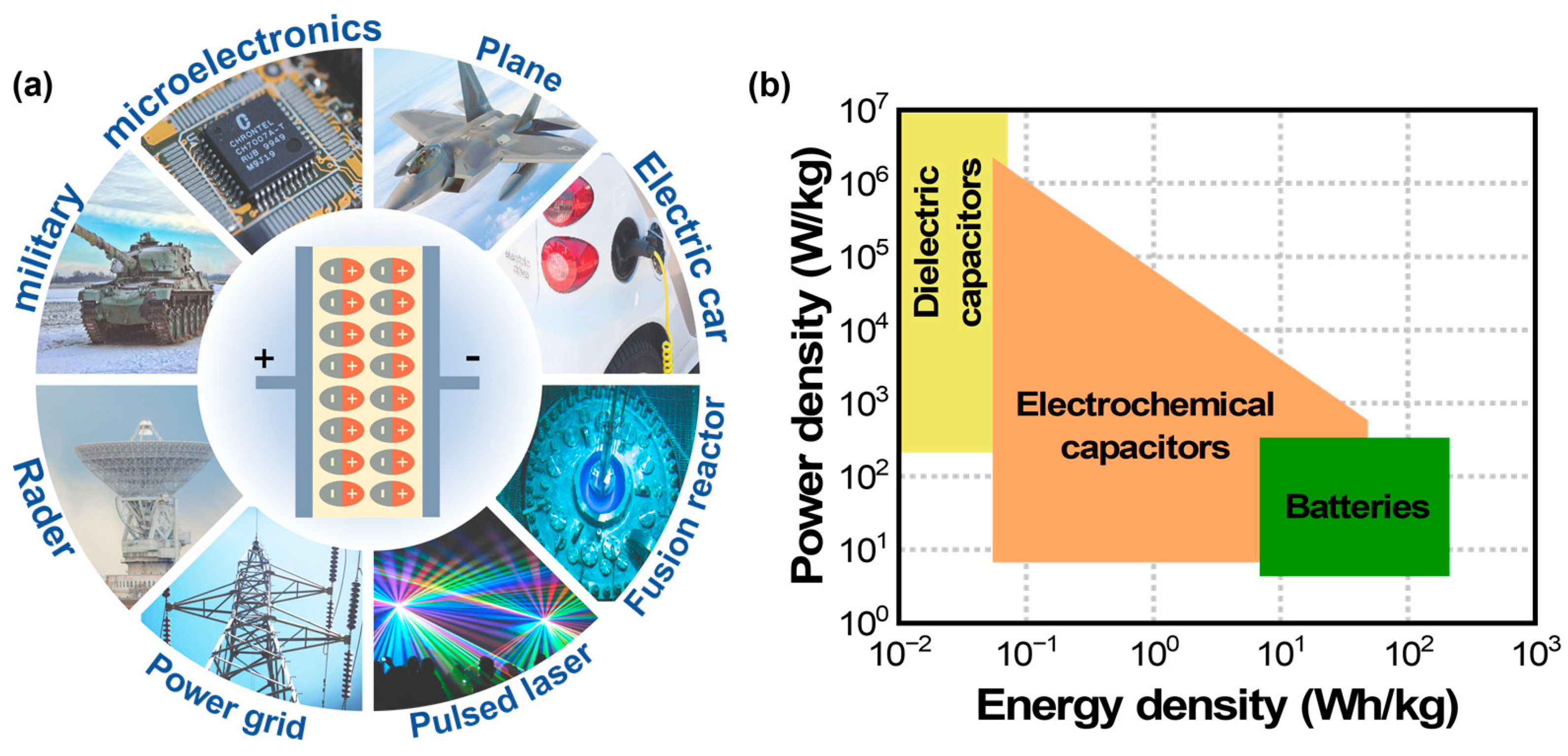
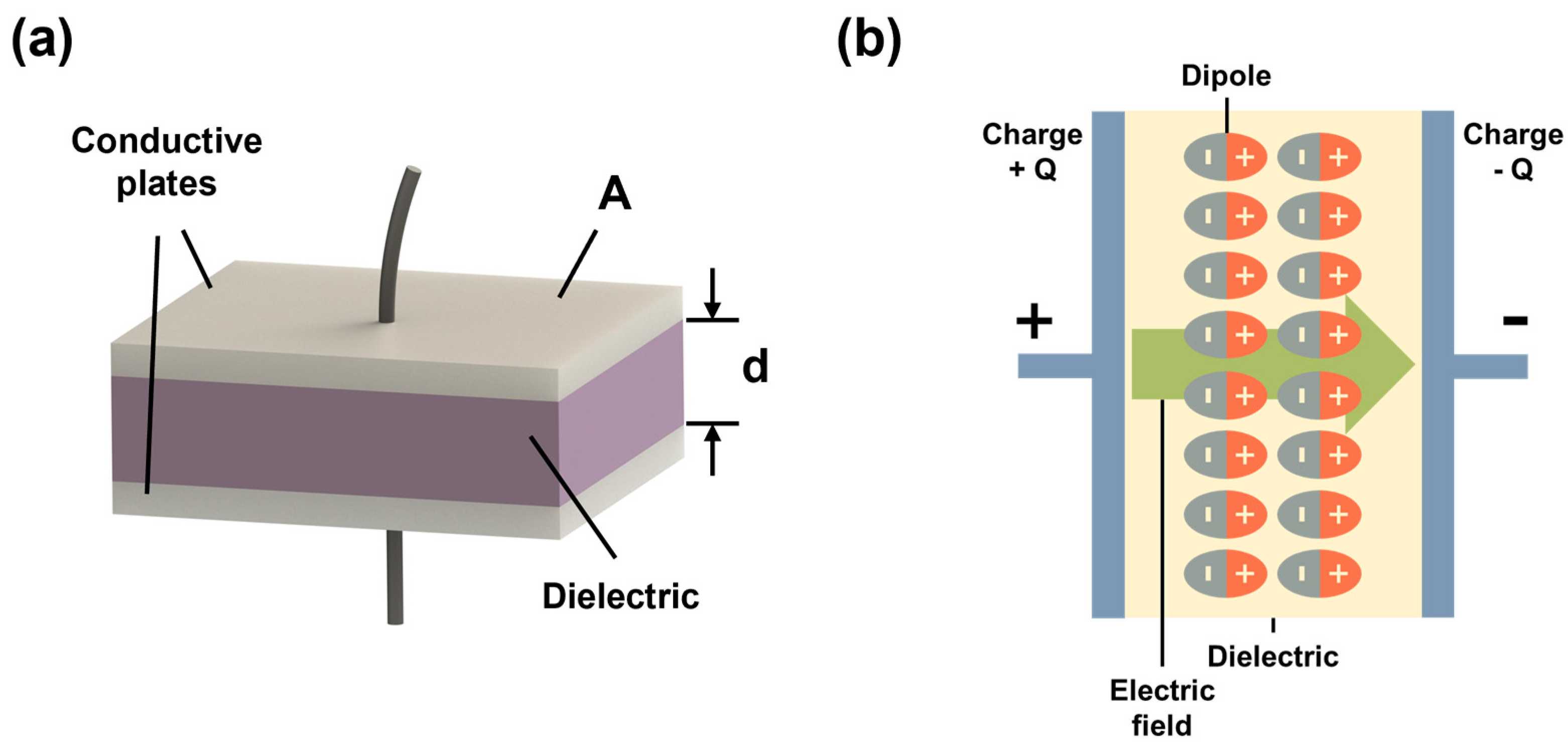
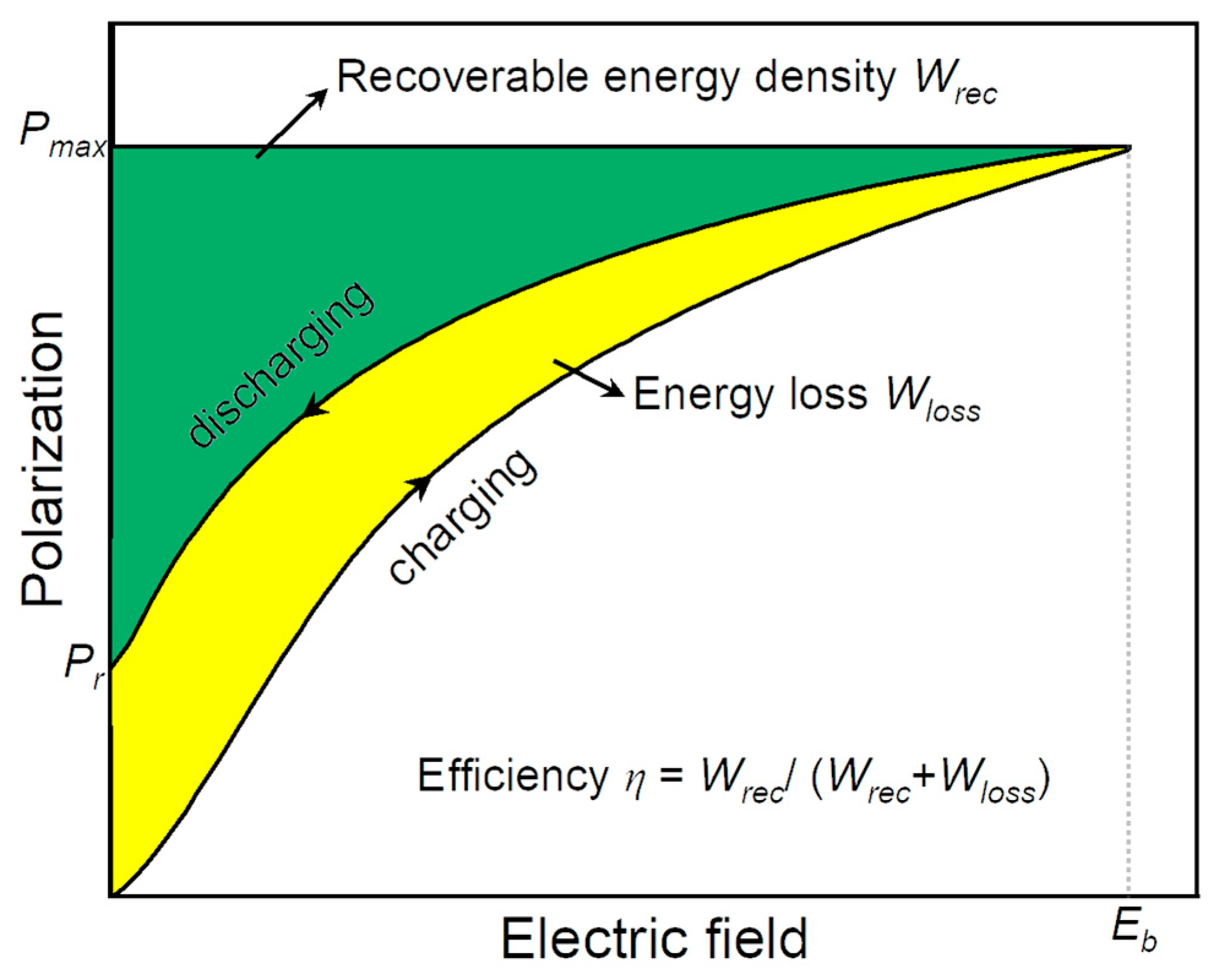
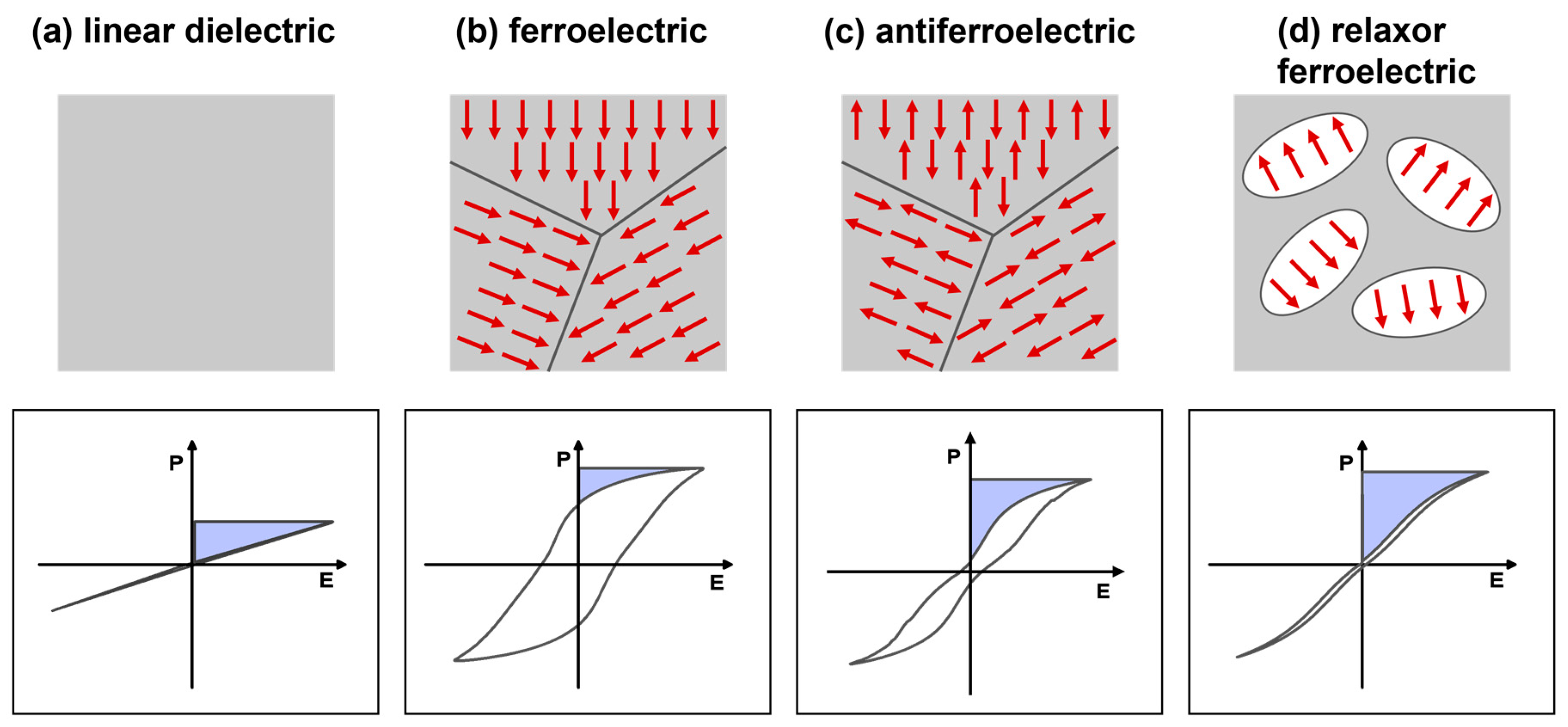
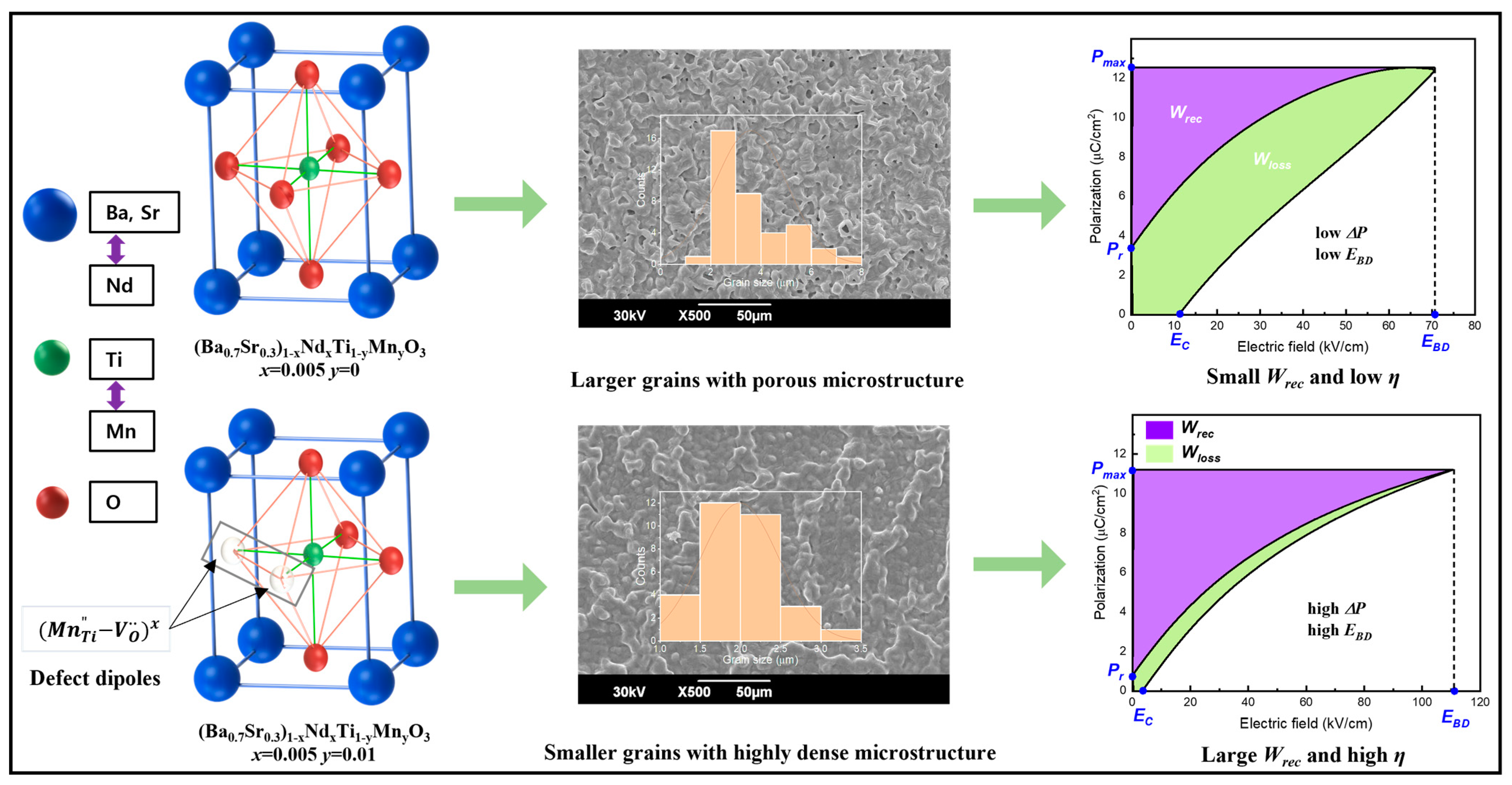
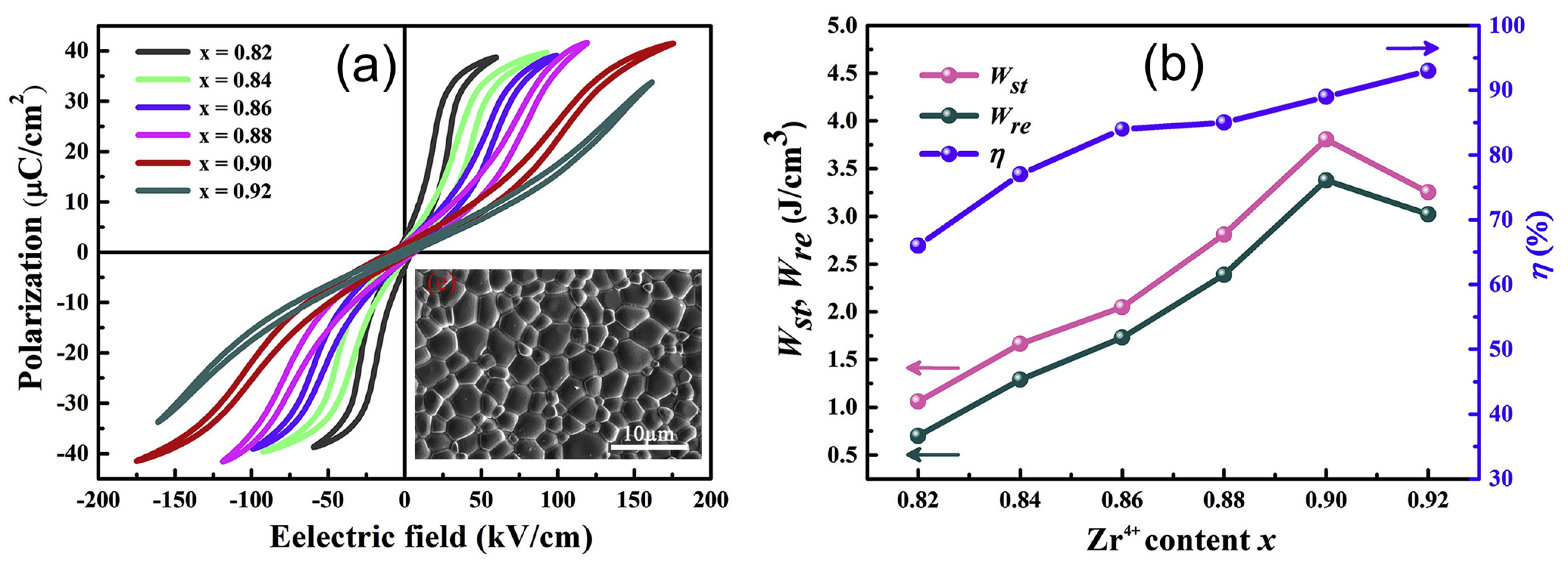


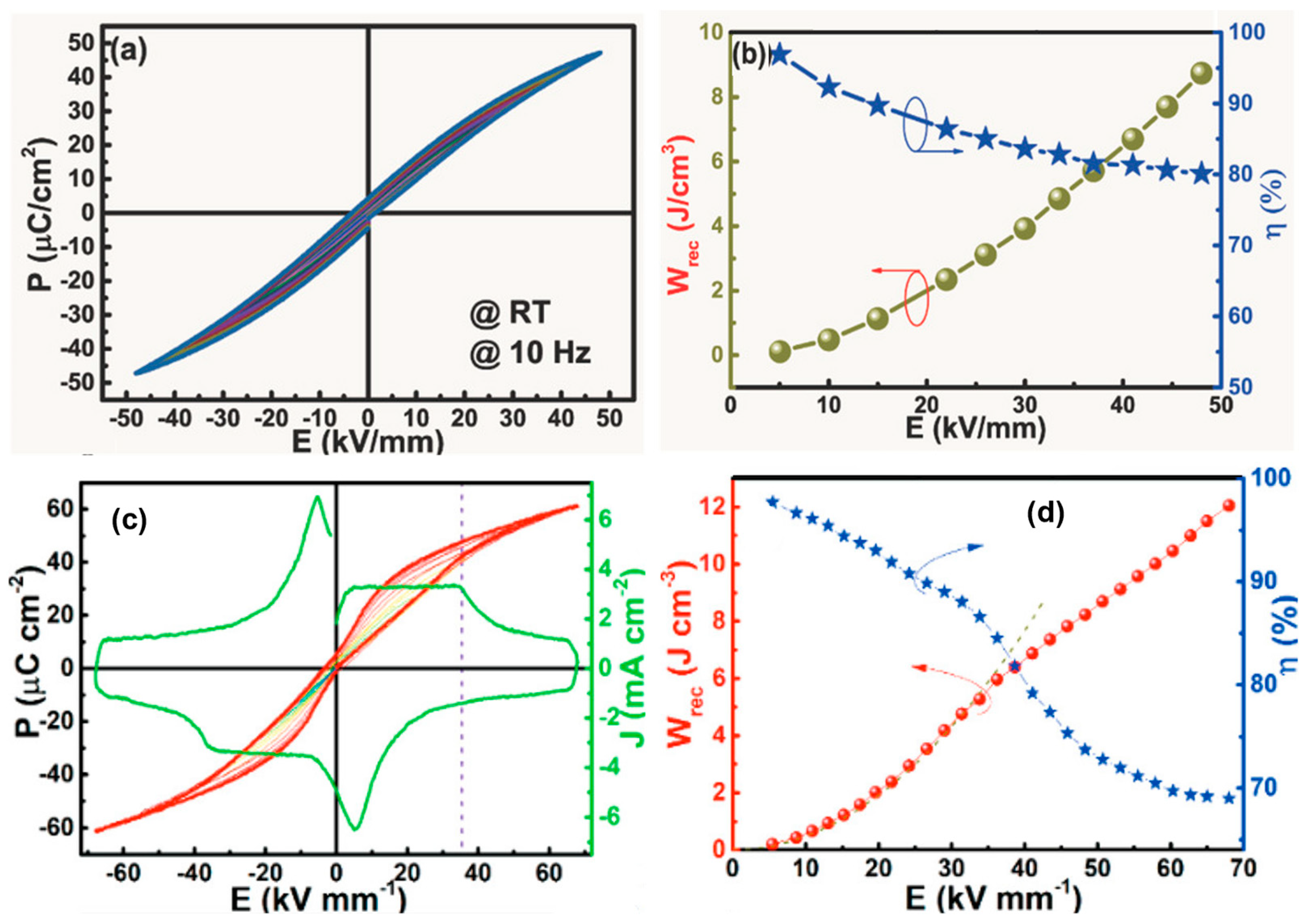
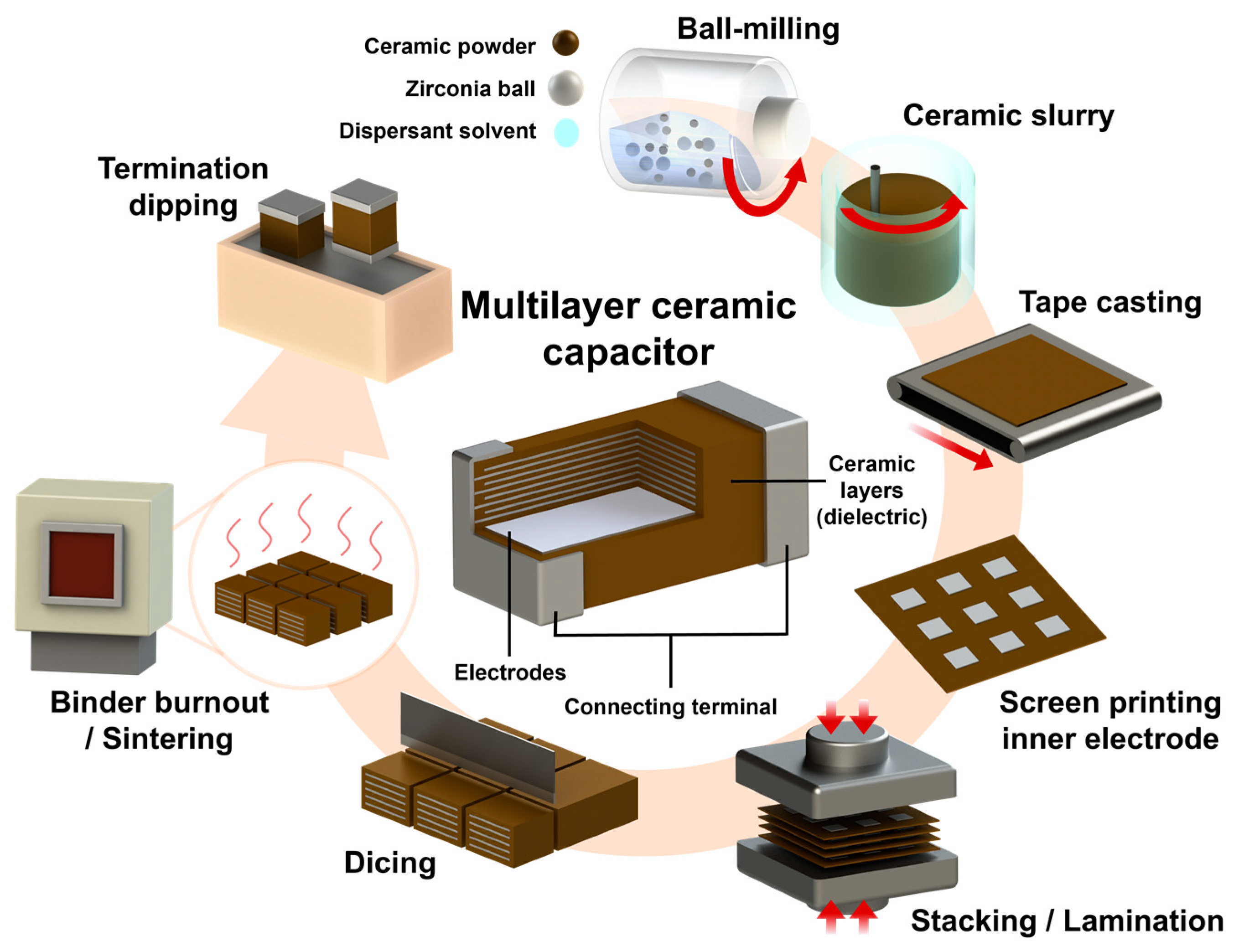
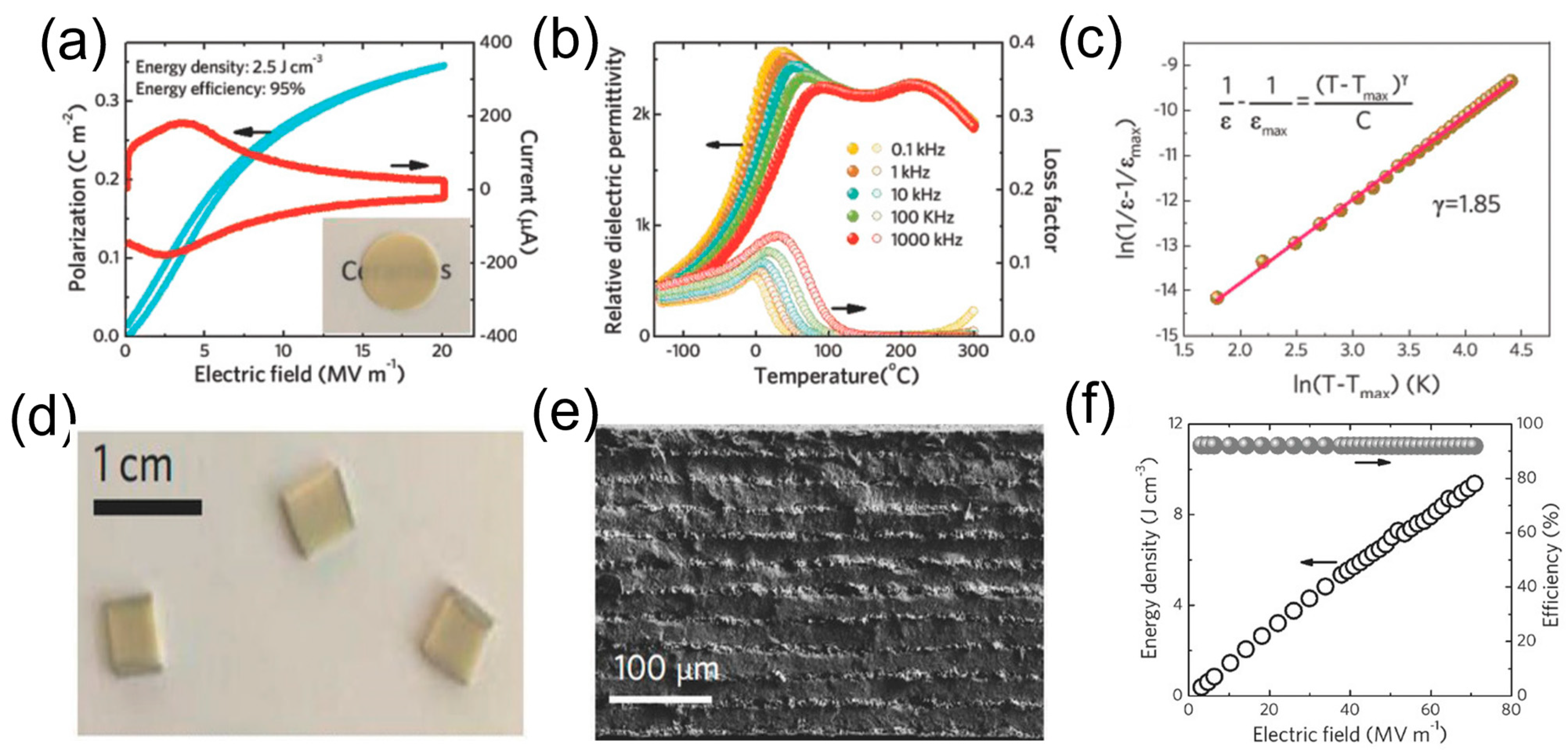
| Bulk Ceramics | Composition | Wrec (J/cm3) | η (%) | Eb (kV/cm) | Refs. |
|---|---|---|---|---|---|
| Ca0.5Sr0.5(Ta0.024Ti0.97)O3-2 wt%SiO2 | 2 | 96 | 360 | [106] | |
| LDs | Ca0.5Sr0.5Ti0.97Sn0.03O3 | 2.06 | 95 | 330 | [107] |
| Ca0.5Sr0.5Ti0.9Zr0.1O3 | 2.05 | 85 | 390 | [108] | |
| (Ca0.5Sr0.5)0.8875La0.075TiO3 | 2.07 | 93 | 370 | [109] | |
| 0.7(Bi0.5K0.5TiO3)-0.3SrTiO3 | 2.31 | 77.7 | 190 | [110] | |
| (Ca0.5Sr0.5)0.99Mg0.01TiO3 | 2.88 | 90 | 460 | [111] | |
| Ca0.5Sr0.5Ti0.85Zr0.15O3 | 3.37 | 96 | 440 | [112] | |
| 0.9(Sr0.7Bi0.2TiO3)-0.1Bi(Ni2/3Nb1/3)O3 | 3.71 | 97 | 340 | [113] | |
| Ca-doped SrTiO3 | 1.95 | 72.3 | 333 | [41] | |
| Zr doped Sr0.98Ca0.02TiO3 | 2.77 | 77.7 | - | [47] | |
| Mg-doped SrTiO3 | 1.86 | 72.3 | 362 | [45] | |
| CaZrO3-0.05SrTiO3 | 5 | - | 1000 | [48] | |
| 0.8CaTiO3-0.2CaHfO3 | 9 | - | 1200 | [43] | |
| FEs | Ba0.3Sr0.7TiO3 | 0.23 | 95.7 | 90 | [49] |
| Nd and Mn-doped Ba0.7Sr0.3TiO3 | 0.41 | 84.6 | 110.6 | [50] | |
| 1.6 wt% ZnO doped Ba0.3Sr0.7TiO3 | 3.9 | - | 40 | [33] | |
| (BaCa)(ZrTi)O3 | 1.28 | - | 243 | [52] | |
| BiFeO3–BaTiO3–Bi(Mg2/3Nb1/3)O3 | 1.27 | - | 110 | [114] | |
| BaTiO3–Bi(Zn2/3(Nb0.85Ta0.15)1/3)O3 | 2.06 | 78 | 180 | [115] | |
| 0.9BaTiO3-0.1Bi(Mg1/2Hf1/2)O3 | 3.38 | 87 | 240 | [116] | |
| AFEs | (Pb0.91Ba0.045La0.03)(Zr0.6Sn0.4)O3 | 8.16 | 92.1 | 340 | [117] |
| 0.84(Bi0.5Na0.5)TiO3-0.16KNbO3 | 5.2 | 88 | 310 | [118] | |
| Ag0.76La0.08NbO3 | 7.01 | 77 | 476 | [119] | |
| Ag0.97Nd0.01Ta0.20Nb0.80O3 | 6.5 | 71 | 370 | [120] | |
| NaNbO3-Bi(Zn2/3Nb1/3)O3 | 2.4 | 90 | 300 | [121] | |
| 0.85(NaNbO3)-0.15(Bi(Ni2/3Nb1/3)O3) | 3.31 | 80.9 | 440 | [122] | |
| (Na0.41La0.09)(Nb0.82Ti0.18)O3 | 6.5 | 66 | 550 | [123] | |
| 0.75[0.90NaNbO3-0.10Bi(Mg0.5Ta0.5)O3]0.25(Bi0.5Na0.5)0.7Sr0.3TiO3 | 8 | 90.4 | 800 | [124] | |
| 0.68NaNbO3-0.32(Bi0.5Li0.5)TiO3 | 8.73 | 80.1 | - | [105] | |
| 0.76NaNbO3-0.24(Bi0.5Na0.5)TiO3 | 12.2 | 69 | 680 | [65] | |
| RFEs | 0.93BaTiO3-0.07YNbO4 | 0.61 | 87 | 173 | [125] |
| 0.65Bi1.05FeO3-0.35BaTiO3-(BiNa0.84K0.16)0.48Sr0.04TiO3 | 0.81 | 60 | 100 | [126] | |
| 0.93BaTiO3-0.07Sr(Zn1/3Nb2/3)O3 | 1.45 | 83.12 | 260 | [127] | |
| 0.88BaTiO3-0.12Bi(Ni2/3Nb1/3)O3 | 2.09 | 95.9 | 220 | [128] | |
| 0.02Ce-doped 0.65BaTiO3-0.35Sr0.7Bi0.2TiO3 | 2.57 | 81.3 | 330 | [129] | |
| (Ba0.65Sr0.245Bi0.07)0.99Nd0.01TiO3 | 4.2 | 80 | 460 | [130] | |
| 0.85(0.95Bi0.5Na0.5TiO3-0.05SrZrO3)-0.15NaNbO3 | 3.14 | 79 | 230 | [131] | |
| Na0.25Bi0.25Sr0.5)(Ti0.8Sn0.2)O3 | 3.4 | 90 | 310 | [132] | |
| 0.88Bi0.47Na0.47Ba0.06TiO3-0.12CaHfO3 | 4.2 | 66.7 | 280 | [133] | |
| 0.75(Bi0.45La0.05Na0.5)0.94Ba0.06TiO3-0.25Sr0.8Bi0.1□0.1Ti0.8Zr0.2O2.95 | 3.84 | 90.8 | 330 | [134] | |
| 0.5(Na0.5Bi0.5TiO3)-0.5(Sr0.85Sm0.1TiO3) | 5.02 | 90 | 422 | [135] | |
| 0.8Bi0.5Na0.5TiO3-0.2SrNb0.5Al0.5O3 | 6.64 | 96.5 | 520 | [136] | |
| 0.70Bi0.5Na0.5TiO3-0.30SrNb0.5Al0.5O3 | 6.78 | 89.7 | 572 | [137] | |
| 0.85K0.5Na0.5NbO3-0.15Bi(Li0.5Ta0.5)O3 | 1.1 | 56 | 151 | [138] | |
| 0.91K0.5Na0.5NbO3-0.09SrZrO3 | 2.81 | 80 | 370 | [139] | |
| 0.9(K0.5Na0.5)NbO3-0.1Bi(Zn2/3Nb1/3)O3 | 4.01 | 97.1 | 326 | [140] | |
| [(Na0.5K0.5)0.91Li0.03](Nb0.88Sb0.06)O3-0.06Bi(Zn1/2Zr1/2)O3 | 4.85 | 88.2 | 480 | [141] | |
| 0.85K0.5Na0.5NbO3-0.15Bi(Zn2/3Ta1/3)O3 | 6.7 | 92 | 600 | [142] | |
| 0.90K0.5Na0.5NbO3-0.10Bi(Zn2/3(Nb0.85Ta0.15)1/3)O3 | 7.4 | 78 | 800 | [143] | |
| 0.85K0.5Na0.5NbO3-0.15Bi(Ni0.5Zr0.5)O3 | 8.09 | 88.46 | 870 | [144] |
| Film Composition | Wrec (J/cm3) | η (%) | Eb (kV/cm) | Refs. |
|---|---|---|---|---|
| BiFeO3-BaTiO3-SrTiO3 | 112 | 80 | 5.3 × 103 | [152] |
| 0.5Ba(Zr0.2Ti0.8)O3–0.5(Ba0.7Ca0.3)TiO3 (BCZT) | 99.8 | 71 | 750 | [153] |
| 0.6(Bi0.5Na0.5)TiO3–0.4Bi(Ni0.5Zr0.5)O3 | 50.1 | 63.9 | 2200 | [154] |
| Mn-doped 0.97(0.93Na0.5Bi 0.5TiO3-0.07BaTiO3)-0.03BiFeO3 | 81.9 | 64.4 | 2285 | [155] |
| Mn-doped 0.55(0.94Na0.5Bi0.5TiO3-0.06BaTiO3)-0.45SrTiO3 | 76.1 | 80 | 2813 | [156] |
| Ba(Zr0.35Ti0.65)O3 | 65.1 | 72.9 | 6.15 × 103 | [157] |
| Sn-doped In2O3/BaZr0.35Ti0.65O3 | 40.6 | 68.9 | 4.23 × 103 | [158] |
| 0.9Bi0.2Sr0.7TiO3–0.1BiFeO3 | 48.5 | 47.57 | 4800 | [159] |
| Mn-doped BiFeO3–BaTiO3 | 80 | 78 | 3.1 × 103 | [160] |
| 0.5(Bi0.5Na0.5)TiO3-0.5Bi(Zn0.5Zr0.5)O3 | 40.8 | 64.1 | 1500 | [161] |
| 0.88Ba0.55Sr0.45TiO3–0.12BiMg2/3Nb1/3O3 | 86 | 73 | 5 × 103 | [162] |
| 0.3Bi(Fe0.95Mn0.05)O3-0.7(Sr0.7Bi0.2)TiO3 | 61 | 75 | 3000 | [163] |
| (Na0.8K0.2)0.5Bi0.5TiO3/0.6(Na0.8K0.2)0.5Bi0.5TiO3-0.4SrTiO3 | 73.7 | 68.1 | 2308 | [164] |
| Na0.5Bi3.25La1.25Ti4O15/BaBi3.4Pr0.6Ti4O15 | 159.7 | 70 | 3450 | [165] |
| Mn-doped 0.65(0.94Na0.5Bi0.5TiO3–0.06BaTiO3)–0.35SrTiO3 | 56 | 66 | 2738 | [166] |
| Sr0.975(Bi0.5Li0.5)0.025Ti0.99Mn0.01O3 | 47.7 | 66.5 | 3307 | [167] |
| Ba(Zr0.1Ti0.9)O3 | 15.5 | 69.8 | 1500 | [168] |
| HfO2/Al2O3/ZrO2 | 54.3 | 51.3 | 5000 | [169] |
| MLCC Composition | Thickness/No. of Active Layers | Wrec (J/cm3) | η (%) | Eb (kV/cm) | Refs. |
|---|---|---|---|---|---|
| 0.75(Bi1-xNdx)FeO3-0.25BaTiO3 (x = 15%) | 32 µm/9 | 6.74 | 77 | 540 | [177] |
| 0.87BaTiO3-0.13Bi(Zn2/3(Nb0.85Ta0.15)1/3)O3 | 17 µm/10 | 8.13 | 95 | 750 | [196] |
| 0.55(Bi0.5Na0.5)TiO3-0.45(Bi0.2Sr0.7)TiO3 | 20 µm/10 | 9.5 | 92 | 720 | [5] |
| 0.62BF–0.3BT-0.08NdZn0.5Zr0.5O3 | 16 µm/7 | 10.5 | 87 | 700 | [178] |
| Sm0.05Ag0.85Nb0.7Ta0.3O3 | 10 µm | 14 | 85 | 1450 | [195] |
| 0.5BiFeO3-0.4SrTiO3-0.03Nb-0.1 BiMg2/3Nb1/3O3 | 8 µm | 15.8 | 75.2 | 1000 | [198] |
| <111>Na0.5Bi0.5TiO3-Sr0.7Bi0.2TiO3 | 20 µm/10 | 21.5 | 65 | 103 × 103 | [194] |
| Ba0.3Sr0.7TiO3/0.85BaTiO3-0.15Bi(Mg0.5Zr0.5)O3 | 230 nm/8 | 30.64 | 70.93 | 3000 | [199] |
| Ba0.7Ca0.3TiO3-BaZr0.2Ti0.8O3 | 100 nm/8 | 52.4 | 72.3 | 4.5 × 103 | [176] |
Disclaimer/Publisher’s Note: The statements, opinions and data contained in all publications are solely those of the individual author(s) and contributor(s) and not of MDPI and/or the editor(s). MDPI and/or the editor(s) disclaim responsibility for any injury to people or property resulting from any ideas, methods, instructions or products referred to in the content. |
© 2024 by the authors. Licensee MDPI, Basel, Switzerland. This article is an open access article distributed under the terms and conditions of the Creative Commons Attribution (CC BY) license (https://creativecommons.org/licenses/by/4.0/).
Share and Cite
Pattipaka, S.; Lim, Y.; Son, Y.H.; Bae, Y.M.; Peddigari, M.; Hwang, G.-T. Ceramic-Based Dielectric Materials for Energy Storage Capacitor Applications. Materials 2024, 17, 2277. https://doi.org/10.3390/ma17102277
Pattipaka S, Lim Y, Son YH, Bae YM, Peddigari M, Hwang G-T. Ceramic-Based Dielectric Materials for Energy Storage Capacitor Applications. Materials. 2024; 17(10):2277. https://doi.org/10.3390/ma17102277
Chicago/Turabian StylePattipaka, Srinivas, Yeseul Lim, Yong Hoon Son, Young Min Bae, Mahesh Peddigari, and Geon-Tae Hwang. 2024. "Ceramic-Based Dielectric Materials for Energy Storage Capacitor Applications" Materials 17, no. 10: 2277. https://doi.org/10.3390/ma17102277
APA StylePattipaka, S., Lim, Y., Son, Y. H., Bae, Y. M., Peddigari, M., & Hwang, G.-T. (2024). Ceramic-Based Dielectric Materials for Energy Storage Capacitor Applications. Materials, 17(10), 2277. https://doi.org/10.3390/ma17102277







